- BOAT OF THE YEAR
- Newsletters
- Sailboat Reviews
- Boating Safety
- Sailing Totem
- Charter Resources
- Destinations
- Galley Recipes
- Living Aboard
- Sails and Rigging
- Maintenance


Hydrofoils for Sailboats
- By By Steven Callahan
- Updated: July 29, 2020
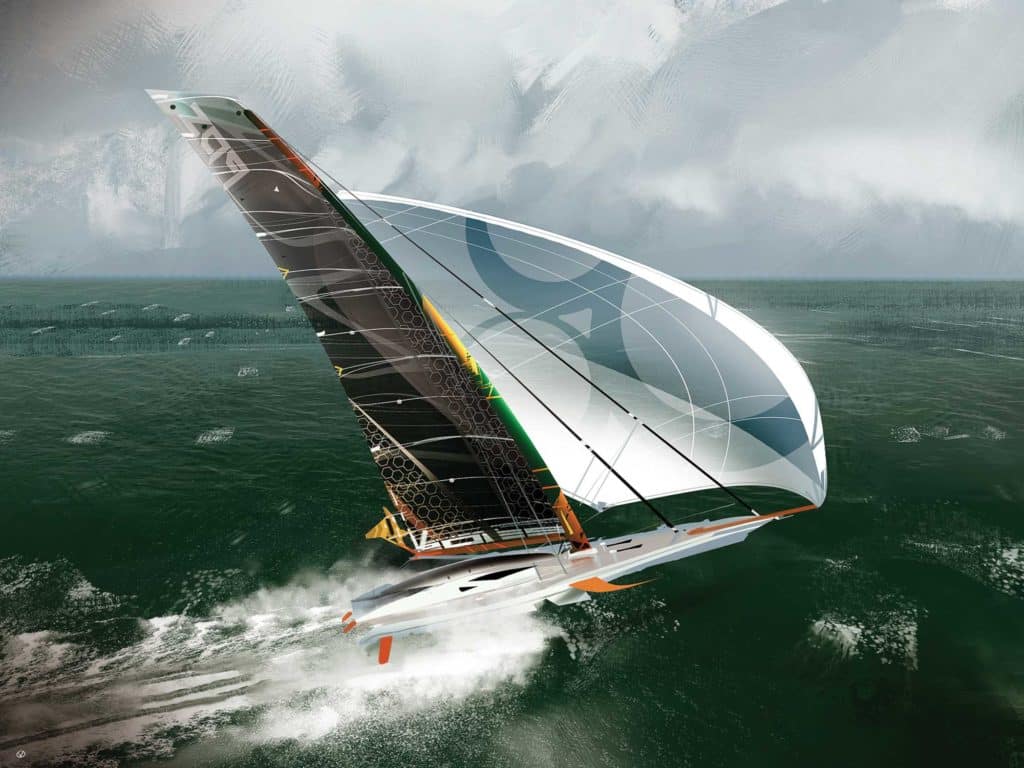
Hydrofoils have been providing dynamic lift since fish sprouted fins. And people have been employing foils ever since they first put paddle to water, and certainly since adding keels and rudders to boats. But the modern, flying America’s Cup boats, kiteboards, Moth dinghies, shorthanded offshore thoroughbreds—these are all playing in a new world in which the terms “hydrofoils” or “lifting foils” describe those oriented to raise a hull or hulls from the water. In these racing realms, if you ain’t got foils, you ain’t got nothin’.
Lifting foils that allow these boats to sometimes home in on three times the wind speed might appear to be of little interest to cruising sailors, but with such common cruising features as self-steering and autopilots, self-tailing winches, rope clutches, fin keels and faster hull shapes all having been passed down from the racing scene, one must ask, “What promise, if any, do hydrofoils hold?”
Lifted or partially lifted boat patents extend back to 1869, but workable watercraft took roots along with early flight. Italian Enrico Forlanini began experimenting with foils in 1898. In 1906, his 1-ton 60 hp foiler reached 42.5 mph. Alexander Graham Bell’s HD-4 Hydrodrome flew on Bras d’ Or Lake at 70 mph in 1919. And several sailing foiler patents began appearing in the 1950s. Notably, JG Baker’s 26-foot monohull, Monitor, flew at 30-plus mph in 1955. Baker experimented with a number of foil configurations, and at least built, if not used, the first wing mast. The first offshore foiler was likely David Keiper’s flying trimaran, Williwaw , in which he crisscrossed the Pacific in the 1960s.
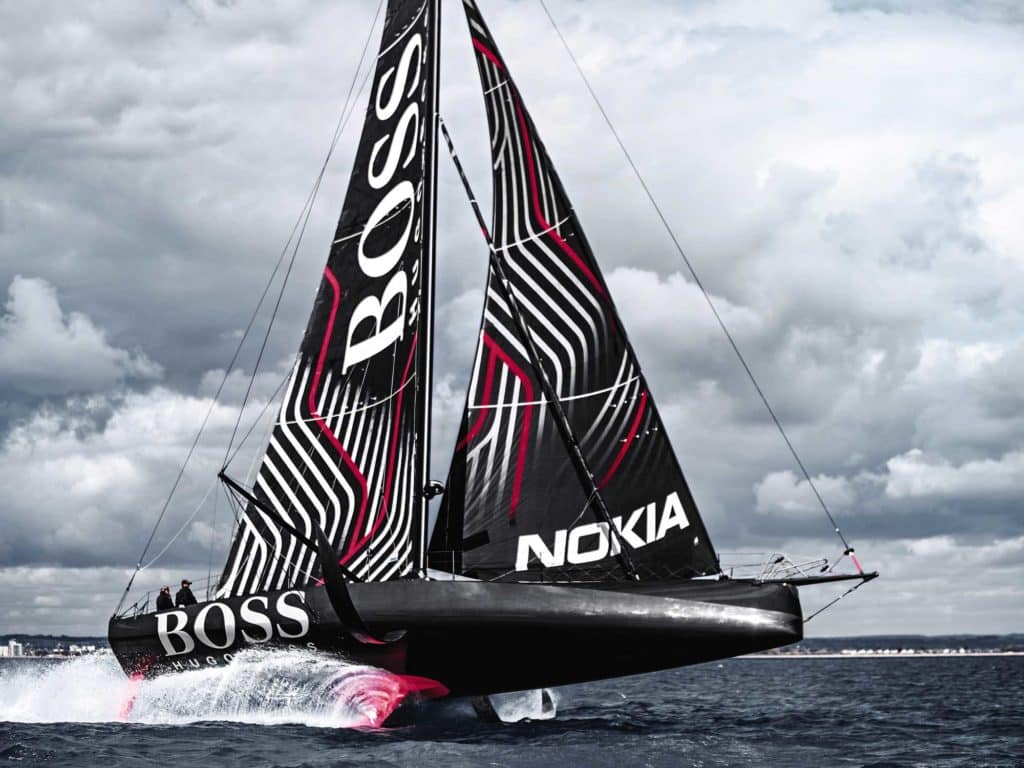
By the 1980s, numerous speed-trial and foil-enhanced offshore-racing multihulls showed huge promise, and have since evolved into behemoth trimarans clocking 30 to 40 knots continuously for long periods, not to mention the monohulls in the Vendée Globe (and soon the Ocean Race) that are capable of speeds exceeding 30 knots. But as boat designer Rodger Martin once reminded me, “If you want a new idea, look in an old book.” He was right. The fully foiling monohulls that will compete in the 2021 America’s Cup will bring things back full circle to the foiling monohull Monitor .
Fluid Dynamics Primer
Any foil—a wing, sail, keel, rudder or lifting foil—redirects the flow of fluid (air included), creating high- and low-pressure areas on opposite sides of the appendage, while developing lift perpendicular to the foil’s surface.
Advancements in foiling science is due in part to the hundreds of foil shapes that were tested, with tabulated results, by the National Advisory Committee for Aeronautics, the forerunner of the National Aeronautics and Space Administration. For the better part of a century now, aircraft and boat designers have been able to choose from a spectrum of refined foil sections that produce predictable amounts of lift and drag for known speeds of fluid and angles of attack, or the angle at which the foil passes through the fluid. Sections of efficient faster foils, as seen on jets or as we flatten our sails to go upwind or reach high speeds, have smaller nose radii and are thinner, with the thickest section of the foils farther aft, up to nearly halfway toward the trailing edge.
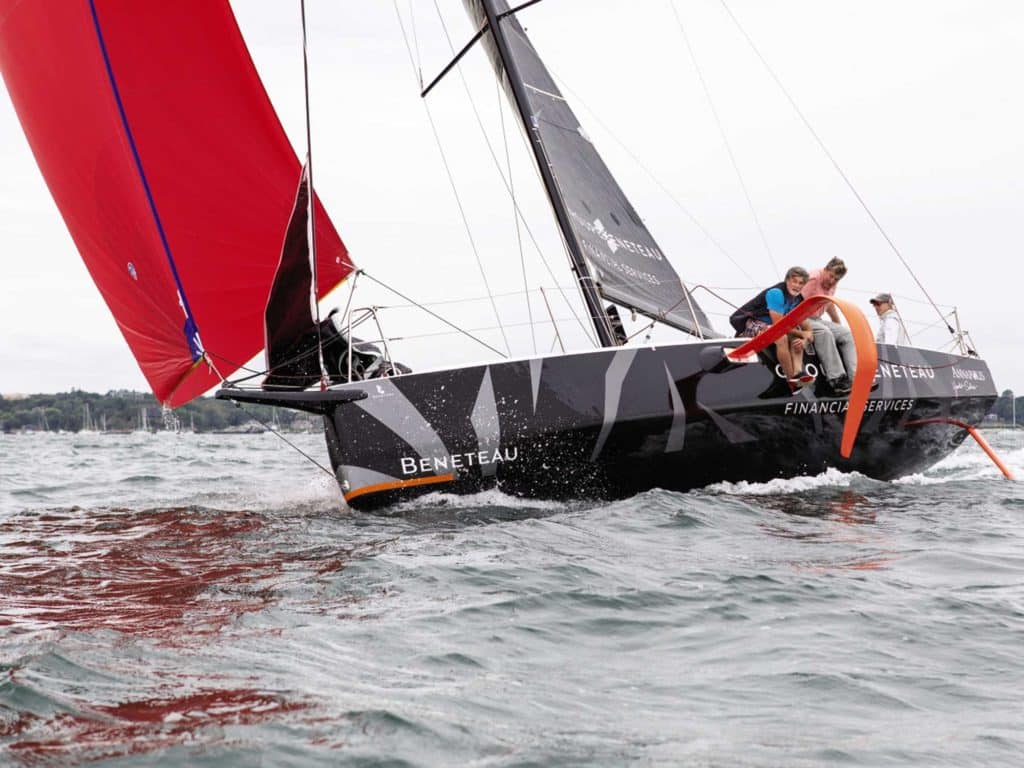
The most efficient foil sections at slow speeds are fatter, with the maximum thickness farther forward, and with larger nose radii, than faster foils. The angle to fluid flow or angle of attack also is greater. We see these slower foils on wings of prop planes and sails when off the wind or in light conditions.
Most sailors are familiar with traditional foils on boats, the teardrop sections of keels that produce lift to weather, reducing leeway, and of rudders, allowing them to steer. Even a flat plate can be a foil, but these tend to be inefficient. Such a shape is prone to fluid separation from the surface, meaning they stall easily, and they maintain poor lift-to-drag ratios. Even keels and rudders are somewhat lift-compromised because they are symmetrical and have to work with fluid coming from either side, whereas lifting foils are more like aircraft wings or propellers, with asymmetrical sections honed for performance in a more stable, fluid flow.
The point is, any foil can be employed at various angles to the surface to prevent leeway, produce increased stability, or help lift the boat out of the water. But those not required to work with fluid flowing from opposite sides can then be honed to maximize lift and minimize drag. Asymmetrical foils were used on boats like Bruce King’s bilgeboarders, including Hawkeye , back in the 1970s. And, designers, including Olin Stephens, had previously employed trim tabs behind keels to improve keel performance.
Sails, which are heeled airfoils, not only drive the boat forward, but they also produce downforce, actually increasing the dynamic displacement of the boat. To counter this and keep the boat sailing more upright, multihull designer Dick Newick first employed slanted asymmetrical hydrofoils in the outer hulls of his small charter trimaran, Lark , in 1962. A portion of the lift developed by the hydrofoil resisted leeway, while a portion worked to actually lift the leeward hull, keeping the boat more upright and reducing dynamic displacement and drag.
Anyone who has ridden on even a foil-stabilized boat will know how riding at least lightly on the waves, and especially above them, beats smashing through them. When boats lift off, everything gets a lot smoother, drag falls away, and the boat accelerates.
Cruising on Foils
But why would a cruiser want to whip over the sea? Wouldn’t this demand an inordinate amount of attention by the crew? Would lifting foils even be applicable to a boat that must have substantial displacement to carry crew and stores? Aren’t cruising-boat hydrofoils an oxymoron?
Maybe, but I believe our boats’ hulls are likely to sprout fins much as fish have as we orient foils to more efficiently resist leeway, add stability, aid steering, reduce drag, increase comfort, allow for shallower draft, and enhance wider variations in hull shapes.
Boats have gotten increasingly wide through the years to advance form stability, improve performance (primarily off the wind), and boost interior volume. But the downside is that fat boats tend to slam more upwind. What if you could reduce dynamic displacement of the boat and lift that hull even partially from the water? The result would be less slamming, especially upwind.
At the same time, what about narrower boats that are known for being more seakindly, especially when closehauled, but lack form stability to carry adequate sail area for powering upwind, and tend to roll badly downwind? Or shallow-draft vessels that are lovely for cruising, but again, tend to suffer from reduced stability? Foils can give that stability back.
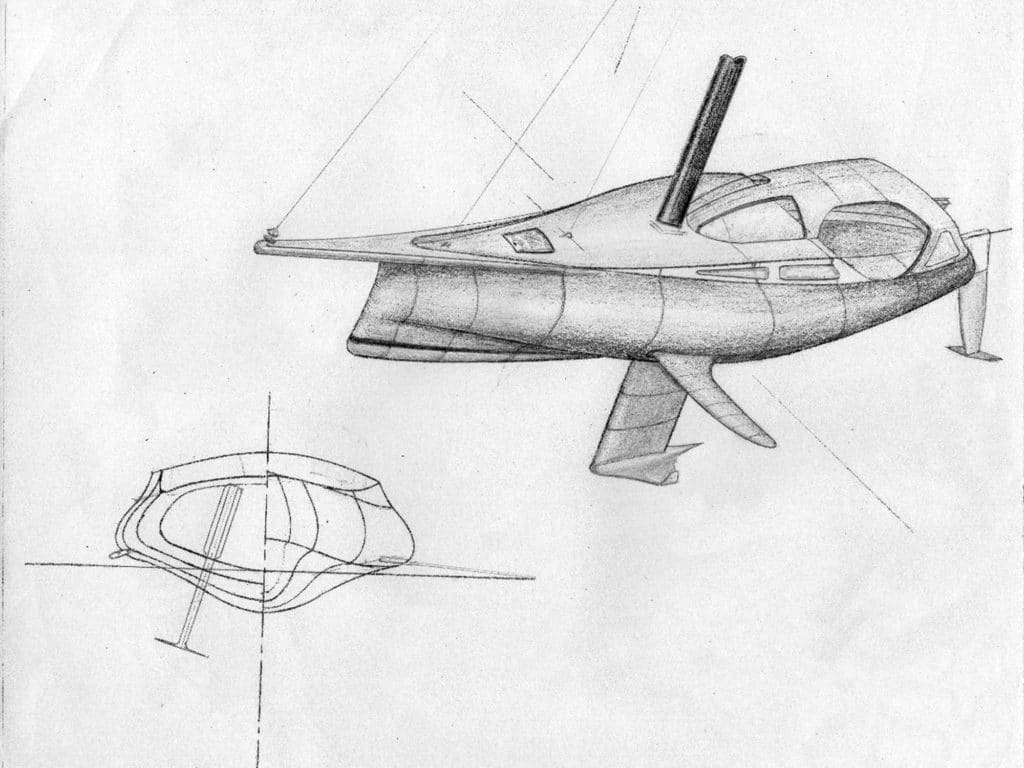
Looking ahead, boat designers might choose to reduce ballast, making up for it with a foil. In short, lifting foils can reduce boat drag and motion while increasing power and performance.
Pitching also does no favors for speed or crew comfort. Foils can come into play here as well. Foils parallel to the sea’s surface resist motion up and down, and a lifted boat skating above chop also is less prone to hobby-horsing through waves. Multihulls have always been particularly susceptible to pitching for a number of reasons, but watching videos of multihulls sailing to weather show an obvious huge advantage that foilers have compared with nonfoilers. Offshore multihulls now routinely employ T-foils on the rudders to control the fore and aft angles of the boat (attitude), a feature easily adaptable to any vessel.
OK, so what’s the cost? Obviously, the more things sticking through the hull, especially if they are retractable, the more it’s going to impact the interior. There would be added weight, complexity and cost. Foils also create noise, and there’s susceptibility to damage from hitting stuff. And let’s not forget compromises with shapes, purposes and things not yet imagined.
As for damage, it’s possible to fold the foils back into the hull. Think swinging center- boards or actual fish fins. Daggerboardlike foils can at least employ shock-absorbing systems similar to the daggerboard arrangements found in many multihulls. This includes weak links that are outside the hull, so if a foil is struck, it frees the foil to fold back or to come off before being destroyed or damaging the hull. Or, foils might hang from the deck rather than penetrating the hull, allowing them to kick up (and to be retrofitted to existing boats). These configurations also relieve the interior of intrusions, and keep the noise more removed from it. I have no doubt that numerous talented designers will be exploring all kinds of options and compromises in coming years, finding ways to make foils both practical and more than worth the compromises.
Sailing more upright, shallower draft, speed, comfort—what’s not to like? Just what is possible? I have a feeling the cruising community is about to find out.
Steven Callahan is a multihull aficionado, boat designer and the author of Adrift , an account of his 76 days spent in a life raft across the Atlantic.
- More: foils , How To , hydrofoils , print june july 2020 , sailboat design
- More How To
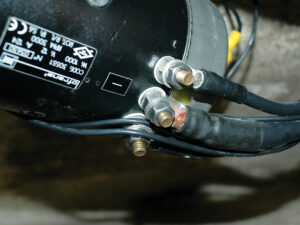
Windlass Maintenance Tips From An Expert
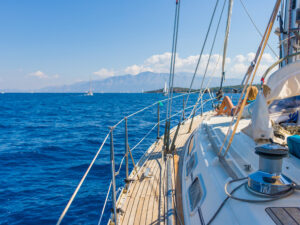
Southern Comfort: Technical Advice for Sailing South
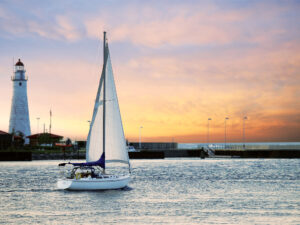
Preparing to Head Out
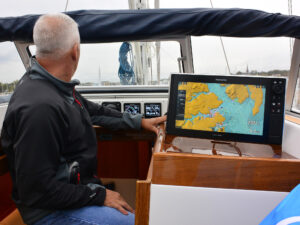
Adding Onboard Electronics? Here’s How To Get Started
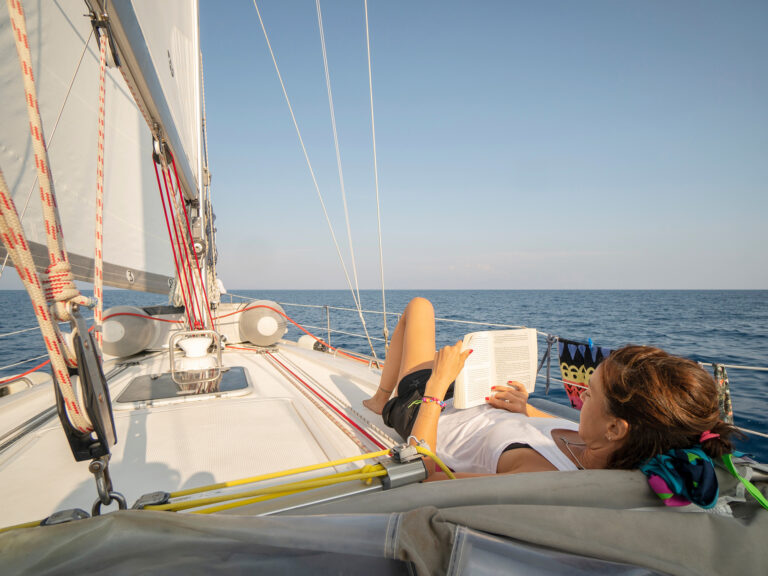
7 Great Reads for Summer Sailing
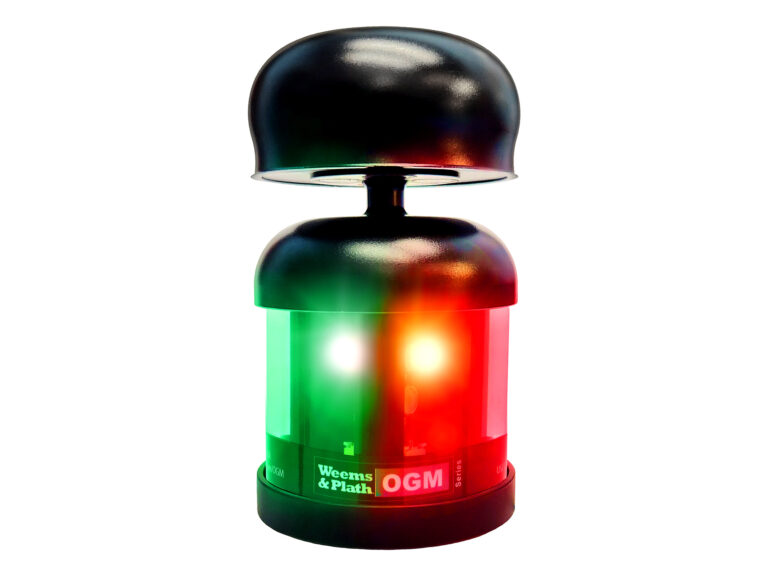
Weems & Plath Introduces BrightWind

Dodging Storms, Chasing Thrills in French Polynesia
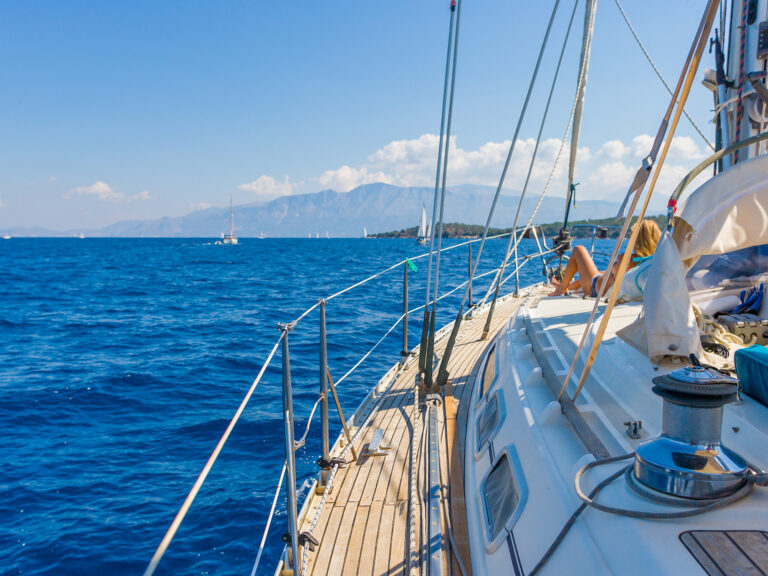
- Digital Edition
- Customer Service
- Privacy Policy
- Email Newsletters
- Cruising World
- Sailing World
- Salt Water Sportsman
- Sport Fishing
- Wakeboarding

Service Locator
- Angler Endorsement
- Boat Towing Coverage
- Mechanical Breakdown
- Insurance Requirements in Mexico
- Agreed Hull Value
- Actual Cash Value
- Liability Only
- Insurance Payment Options
- Claims Information
- Towing Service Agreement
- Membership Plans
- Boat Show Tickets
- BoatUS Boats For Sale
- Membership Payment Options
- Consumer Affairs
- Boat Documentation Requirements
- Installation Instructions
- Shipping & Handling Information
- Contact Boat Lettering
- End User Agreement
- Frequently Asked Questions
- Vessel Documentation
- BoatUS Foundation
- Government Affairs
- Powercruisers
- Buying & Selling Advice
- Maintenance
- Tow Vehicles
- Make & Create
- Makeovers & Refitting
- Accessories
- Electronics
- Skills, Tips, Tools
- Spring Preparation
- Winterization
- Boaters’ Rights
- Environment & Clean Water
- Boat Safety
- Navigational Hazards
- Personal Safety
- Batteries & Onboard Power
- Motors, Engines, Propulsion
- Best Day on the Water
- Books & Movies
- Communication & Etiquette
- Contests & Sweepstakes
- Colleges & Tech Schools
- Food, Drink, Entertainment
- New To Boating
- Travel & Destinations
- Watersports
- Anchors & Anchoring
- Boat Handling
Hydrofoils: Boats That Fly
Advertisement
Hydrofoils make everything from water skis to sailboats to giant ferries faster (much faster). But how the heck do they work?
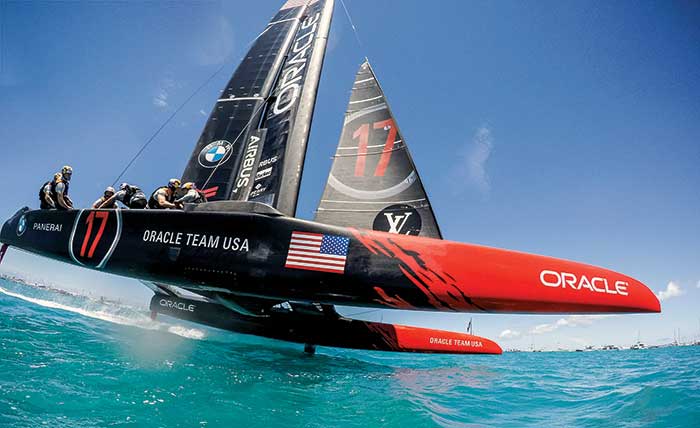
Oracle Team USA's AC50 "flying" at nearly 50 mph. (Photo: Ricardo Pinto)
Ever wonder why a sleek, powerful recreational boat is not even as fast as a typical economy car? It has to do with friction. An economy car needs a little over 100 horsepower to speed by at 100 mph, but pushing a boat through the water that fast takes several hundred horsepower. The reason is that water is almost 800 times denser than air.
Imagine standing on your dock in a 10-knot wind — it's not hard to do. Now imagine being in a river trying to stand up to a 10-knot current. The water is so much denser that no matter how strong you are, you'd be swept away. A boat hull has to push through all that dense water while a car can slip through the air much easier.
Planing boats are able to go faster than displacement boats because they lift part of their hull out of the water as they race over their bow wave, but there's still a lot of friction from the water on the rest of the hull. If you could get the hull all the way out of the water, you'd eliminate that friction, and the boat could go faster with the same amount of power.
The Science
Most of us have a pretty good understanding of how an airplane flies. As air flows over and under the wings (also called airfoils), it creates lift. Once an airplane is going fast enough, the lift that the wings create allow it to rise above the earth.
If you were to mount a wing or two (called hydrofoils) under a boat, all that dense water can be put to good use by pushing the boat's hull out of the water. Then friction only acts on the small foils, not on the whole hull, which is why a 130-foot hydrofoiling sailboat can "fly" at over 50 knots. Powerboats have added friction from the propulsion system that has to remain in the water, but even then, large hydrofoiling ferries can exceed 45 knots.
Speed is not the only advantage that hydrofoils give boats. Because the hull is out of the water, all the energy from waves that would normally pound against the boat pass harmlessly underneath it, creating an eerily smooth ride. Even so, hydrofoiling is typically best in somewhat protected waters.
Don't look for hydrofoils on your next runabout anytime soon because they're much more difficult to engineer and typically triple the cost of a boat. The good news is that there are other ways to 'foil that are affordable — see "Experience Hydrofoiling For Yourself" at below.
Experience Hydrofoiling For Yourself
Hydrofoil kiteboards.
If you've even seen a kiteboard zooming in a strong breeze, you know they're plenty fast. Add a hydrofoil, and suddenly you add a new dimension. These boards take lots of skill and practice to master, but the ride is said to be much smoother and even faster than a conventional kiteboard. Cost starts at around $1,000.
Hydrofoil Waterskis
These single-ski hydrofoils are really a sit-on-ski, and once you've mastered the technique, the foils will lift you up and you'll be "flying." Unlike conventional skis, these aren't designed for speed, and 18 mph is where they typically "liftoff' and suggested top speed is about 25 mph. It's also important not to ski in shallow water due to the depth of the foils. Cost is typically $1,500 and up.
Hydrofoil Windsurfers
Not content to take a surfboard and add a sail, windsurfers developed foils that allow the board to "levitate." The biggest advantage is the smoothness of the ride — a real benefit because these rigs usually sail in very strong winds with plenty of chop. Cost is about $2,500 to get started.
Hydrofoiling Small Sailboats
You don't have to spend millions on a boat like the America's Cup racers if you want to hydrofoil. The Waszp costs about $10,000, though even for dinghy racers, there's a learning curve to get these boats on their foils, with speeds up to 27 mph.
Note that most companies suggest wearing a helmet when using foiling products because of the speeds achievable and the hard, sharp foils these devices have.
Foiling The Competition
America's Cup boats are often what people think of when they hear the word "hydrofoil." Hal Youngren, an aeronautical engineer and one of the designers for the 2013 and 2017 America's Cup racers, says the difference in speed that foils make is impressive. The fastest nonfoiling catamarans in previous races could barely reach 35 knots, while the 2017 foiling cats hit 50 knots. Youngren says that these 50-foot cats are able to lift their hulls completely out of the water using only about three-quarters of a square meter of foil area (about the size of a medium-sized TV). Below about 15 knots, he says, the boats sail much like a nonfoiling boat with hulls in the water, but once over that speed, the boats start to "fly" and their speed dramatically increases.
The America's Cup Class AC75 Boat Concept Revealed
An exciting new era in America's Cup racing was unveiled in November 2017 as the concept for the AC75, the class of boat to be sailed in the 36th America's Cup is released illustrating a bold and modern vision for high performance fully foiling monohull racing yachts.
The America's Cup AC75 Boat Concept Revealed
The Emirates Team New Zealand and Luna Rossa design teams spent the previous four months evaluating a wide range of monohull concepts. Their goals have been to design a class that will be challenging and demanding to sail, rewarding the top level of skill for the crews; this concept could become the future of racing and even cruising monohulls beyond the America's Cup.
The AC75 combines extremely high-performance sailing and great match racing with the safety of a boat that can right itself in the event of a capsize. The groundbreaking concept is achieved through the use of twin canting T-foils, ballasted to provide righting-moment when sailing, and roll stability at low speed.
An underlying principle has been to provide affordable and sustainable technology "trickle down" to other sailing classes and yachts. While recent America's Cup multihulls have benefitted from the power and control of rigid wing sails, there has been no transfer of this technology to the rigs of other sailing classes. In tandem with the innovations of the foiling system, Emirates Team New Zealand and Luna Rossa are investigating a number of possible innovations for the AC75's rig, with the requirement that the rig need not be craned in and out each day. This research work is ongoing as different concepts are evaluated, and details will be released with the AC75 Class Rule before March 31, 2018.
The America's Cup is a match race and creating a class that will provide challenging match racing has been the goal from the start. The AC75 will foil-tack and foil-gybe with only small maneuvering losses, and given the speed and the ease at which the boats can turn the classic pre-starts of the America's Cup are set to make an exciting comeback. Sail handling will also become important, with cross-overs to code zero sails in light wind conditions.
A huge number of ideas have been considered in the quest to define a class that will be extremely exciting to sail and provide great match racing, but the final decision was an easy one: the concept being announced was a clear winner, and both teams are eager to be introducing the AC75 for the 36th America's Cup in 2021. — AmericasCup.com
Related Articles
The truth about ceramic coatings for boats.
Our editor investigates the marketing claims of consumer-grade ceramic coatings.
Fine-Tune Your Side Scan Fishfinder
Take your side-scanning fishfinder off auto mode, and you’ll be spotting your prey from afar in no time
DIY Boat Foam Decking
Closed-cell foam flooring helps make boating more comfortable. Here’s how to install it on your vessel
Click to explore related articles
Charles Fort
Contributing Editor, BoatUS Magazine
Charles Fort is BoatUS Magazine's West Coast Editor. He often writes local news items for BoatUS Magazine's Waypoints column and contributes to Reports, in-depth tech features in every issue written to help readers avoid accidental damage to their boats. He is a member of the National Association of Marine Surveyors, he's on ABYC tech committees, and has a 100-ton U.S. Coast Guard license. He lives in California.
BoatUS Magazine Is A Benefit Of BoatUS Membership
Membership Benefits Include:
Subscription to the print version of BoatUS Magazine
4% back on purchases from West Marine stores or online at WestMarine.com
Discounts on fuel, transient slips, repairs and more at over 1,200 businesses
Deals on cruises, charters, car rentals, hotel stays and more…
All for only $25/year!
We use cookies to enhance your visit to our website and to improve your experience. By continuing to use our website, you’re agreeing to our cookie policy.

Published on June 2nd, 2017 | by Assoc Editor
Foiling and Foil Shapes, a Beginner’s Guide
Published on June 2nd, 2017 by Assoc Editor -->
by Mark Chisnell, Land Rover BAR The rules covering the design and construction of the team’s America’s Cup Class (ACC) boat have defined many of the parts of the boat, including the hull and crossbeams (together called the platform), and the wing shape and size. What’s left for the team’s designers and engineers to work on is principally the daggerboards and rudders, and the control systems that operate them along with the wingsail.
A lot of the technology that goes into the control systems is hidden well inside the hull, with just glimpses of the HMI (human machine interface) that the sailors use to control the board rake, wing trim and so on. The foils are on full view however, so we thought a beginners guide to ACC foil design would come in useful now the racing is approaching.
Basic Principles The foils use exactly the same scientific principles as an aircraft wing. Just as an aircraft wing will lift a plane up off the ground, the foils of an America’s Cup Class boat will lift it out of the water. Wings are foils too, called aerofoils because they work in air. The foils on the new America’s Cup boats are more accurately called hydrofoils, because they work in water.
The secret to both types of foil is the shape – aerofoils and hydrofoils use a special shape to guide the wind or water around them, and generate the lifting force to get planes and boats up in the air. Of course, the America’s Cup boats also use an aerofoil. The main wingsail works exactly the same way as an aircraft wing, it’s just rotated to stand up straight, rather than lie flat.

While an aircraft needs an engine to push the air over the wing fast enough to generate enough force to lift the aircraft up off the ground, the wingsail on the Cup boat generates force from the wind blowing past it. The harder the wind blows, the more force it makes to push the boat forward. When the boat is going fast enough, the hydrofoils will then be able to create enough force to lift the boat out of the water. This reduces resistance to the forward motion and the boat goes faster still.
There are four hydrofoils on the boat — we count the rudders at the back because they have small wings at the tips called elevators. However, the real power to keep the boat in the air comes from the hydrofoils (the daggerboards, as you will often hear them called by the sailors) and we will concentrate on these.
The L-Foil The L-foil is exactly that; a vertical daggerboard shaft that goes through the hull of the boat, with a single horizontal hydrofoil on the bottom, the whole thing shaped like an ‘L’. If nothing else changes, then the L-foil keeps generating lift as the boat goes faster and so the boat keeps rising, and as it rises, less and less of the daggerboard is in the water.
At the basic level, two things then happen: firstly, the boat starts to slip sideways because there is less of the vertical part of the daggerboard in the water and this makes the boat feel unstable and hard to steer. Then, ultimately, if the boat keeps rising the horizontal part of the board that is doing all the lifting will break the surface. If it does, there will be a catastrophic loss of lift and the boat will come crashing back down.
Aircraft use moving parts on the foils to control the amount of lift – trailing edge flaps — but the rules forbid these on the ACC boats, so to maintain stable flight the sailors change the rake or angle of attack of the whole dagger board (and hence the foil) to the water.
Rake If you rake the board backwards as the boat accelerates, the lift will reduce and the boat will come to an equilibrium at a steady height above the water. This is all well and good until the conditions change, maybe the wind speed goes up or down, or the boat hits some waves. When that happens the rake will need further adjustment to find the new equilibrium… until the next puff or lull when it must change again.
In the big breeze and rough water of San Francisco Bay in the 34th America’s Cup it turned out that these moments of equilibrium didn’t last very long and on occasions barely existed at all. The crew’s ability to generate the hydraulic power to change the board and wing trim was simply overwhelmed; they couldn’t achieve stable flight.
V-foil The solution was what’s called the V-foil, in which the horizontal part of the ‘L’ is angled upwards to form more of a ‘V’ shape (the angle at the bottom of the ‘V’ is called the dihedral – a dihedral of 90 degrees would define an L-foil, less than that is progressively more of a V-foil).
The V-foil uses the same principle as one of the most successful original foiling powerboats. The grand old man of 19th century innovation, Alexander Graham Bell put a couple of 350hp engines on the back of what was called HD-4 and set a new marine world speed record in 1919 of just over 70mph.
HD-4 used three ‘ladders’ of small foils, one at the front, and one each side close to the back. When the boat accelerated it started to lift out of the water, and as it lifted, one by one the ‘rungs’ of the foils would break clear of the water. As they did so the lift would decrease, and unless the boat continued to accelerate the boat would stop rising and settle at an equilibrium.
The V-foil achieves this same effect with a single foil and is used in the commercial application of fast ferries— one runs between Southampton and Cowes on the Isle of Wight, right across the Solent waters where the team train, and has done so (on and off) since 1969 – so V-foils are well understood.
When a boat equipped with a V-foil keeps rising as more lift is generated by faster speeds, both parts of the ‘V’ come out of the water together. Critically, when the ‘horizontal’ section starts to break the surface at the tip, it has the effect of reducing the lift gradually, because it doesn’t all come out of the water together. So the boat comes back down gently, working towards an equilibrium ‘ride height’ of its own accord.
It might be that it doesn’t reach this equilibrium before something else changes, but the V-foil has some inherent stability (unlike the L-foil) that doesn’t require human intervention. The shape provides a feedback mechanism to control the amount of lift and produce a more stable ride at a consistent height above the water. The downside of the V-foil is that it will generate less lift and more drag than the L-foil under the same conditions, because some of the lift generated is pushing sideways rather than up.
So one of the big questions facing the teams at the outset of this campaign was whether or not the sailors could achieve stable flight with an L-foil in the new boats and the new venue. Bermuda was a very different place to San Francisco; the winds were expected to be lighter, the water flatter and it seemed that stable flight should be easier to achieve with an L-foil under human control.
A huge amount of work has gone into foil and control system design and we now know that the answer is yes, they can – all the teams are using L-foils, often with unloaded dihedral angles of greater than 90 degrees. These angles close as the boat sails and the foil is loaded up to become much closer to, or 90 degrees.
Cant Another buzz word for the 35th America’s Cup is the cant. The cant of the board is similar to the rake, except that the bottom of the board is moving sideways across the boat, to and from the centreline, rather than backwards and forwards. When the board is canted outwards (towards the edge of the boat) it creates greater ‘righting moment’ and more power to drive the boat forwards.
Righting Moment When the wind hits a sail it creates the force to move the boat forward but it also creates a force that is trying to tip the boat over. If you have ever seen a dinghy or yacht knocked flat by a big gust of wind then you’ve already got the idea.
It’s considerably simplified, but essentially the more force that can be applied to resist the wind’s effort to tip the boat over, then the faster the boat will go, because more of the wind’s energy can be captured and applied to forward motion. The resisting force is called the righting moment and creating as much righting moment as possible is a fundamental principle of designing fast sailboats. It’s the reason that you see people leaning over the windward side when they are racing, putting bodies as far out on the windward side as possible is creating righting moment.
S-Foil Finally, there’s the question of whether the vertical part of the daggerboard should be straight or ‘S’ shaped. The curve of the S-foil could be used — like the cant — to move the bottom of the board outboard and increase the righting moment. So S-foils are more powerful, but they are also more difficult to use. The curves have to raised up and down through the bearings and internal mechanisms in the hull, and that means a lot of work to keep the friction down and the efficiency high.

Tags: AC35 , America's Cup , foiling , Land Rover BAR , Mark Chisnell
Related Posts
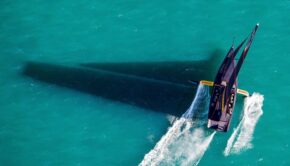
Speed, excitement, and sex appeal →

May update for 37th America’s Cup →
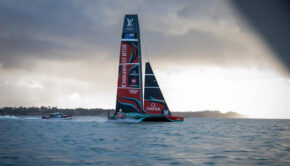
Defending the America’s Cup offshore →
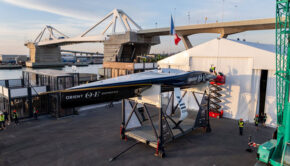
French join America’s Cup splash party →
© 2024 Scuttlebutt Sailing News. Inbox Communications, Inc. All Rights Reserved. made by VSSL Agency .
- Privacy Statement
- Advertise With Us
Get Your Sailing News Fix!
Your download by email.
- Your Name...
- Your Email... *
- Phone This field is for validation purposes and should be left unchanged.


Hydrofoil Boats (Everything You Need to Know)
Despite the technology being around for over a hundred years, hydrofoil boats have once again become a hot topic amongst boat enthusiasts. Hydrofoil technology enhances both speed and efficiency of water vessels, and has been used by US Navy watercrafts, superyachts, racing boats, ferries, and many more.
A hydrofoil boat is supported by a winglike structure that creates lift as the boat’s speed increases. This makes the boat faster and smoother by reducing drag and keeping the boat above the waves.
With hydrofoil boats making headlines once again, it’s time to go over what they are, how they work, their advantages, disadvantages, and a serious evaluation on whether they are the future of boating or not. In this article, we’ll go over all there is to know about hydrofoils.
Table of Contents
What is a Hydrofoil Boat?
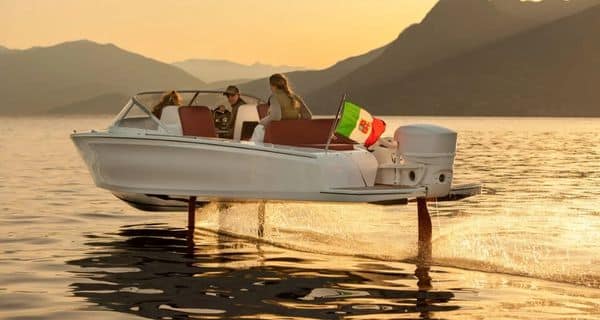
A hydrofoil boat is supported by a “hydrofoil” which is a structure composed of either a wing (V), T, or U shape. There are two types of hydrofoil boats: surface-piercing, and fully submerged. Both types of hydrofoils achieve the same purpose of lifting the boat off the surface of the water at high speeds.
When going fast enough, the lift of the foils is great enough to lift the entire hull of the boat out of the water, so that nothing but the foils themselves are touching the surface. This has some incredible benefits in terms of speed, efficiency, and experience – all of which we will soon go over.
Hydro foils help minimize drag and improve speed which is very similar to the effects achieved by aerofoils used on airplanes.
Hydrofoil boats are powered mainly in the same way other power boats are, by propellers or water jets. With that being said, they are also really popular in sailing. But the use of hydrofoils on sailboats is highly technical and primarily used by racing teams. They are most commonly used by commercial boats, and now are being introduced at the consumer level with pleasure boats.
History of the Hydrofoil Boat
The hydrofoil technology was first developed by inventors Casey Baldwin, Enrico Forlanini, and Alexander Graham Bell – yep, the same guy who invented the telephone. Forlanini had a prototype operating on Lake Maggiore in Italy by 1909. The hydrofoil boat achieved fame in WWII when it was used by both the German and US Navy to navigate waters that were heavily guarded by mines.
During the 1960s, 70s, and 80s, the hydrofoil technology was taken to water sports, where it was used in kiteboards, surfboards, and the air chair. It returned to the consumers’ attention in the 2010s, when it was used by racing teams across the world to set speed and time records in sailing championships. Most recently, watercraft companies have begun experimenting with the idea of hydrofoils on smaller scale boats outfitted with propelled and outboard engines.
How does a Hydrofoil Boat work?
So, we know that hydrofoils help boats achieve higher speeds with less drag, but how does that really work? The best way to think of it would be as “a boat with wings,” as that is essentially what they are. Just like an airplane would lift off the ground or water, as a hydrofoil boat gains speed, it lifts off the water too. While the foils themselves are submerged in the water still, much of the time there is enough lift to hold the entire hull of large ships and ferries off the surface. The sensation of being in a hydrofoil boat is much like being in an airplane that has limited flight. It’s smooth, and it’s really fast.
At the consumer level, hydrofoils require additional technology. As we’ll go over later on, this can result in some expensive price tags. As you can imagine, a boat that essentially “flies” through the air comes with some safety hazards. Hydrofoils require an automatic control system that maintains flying height, foil pitch, and smoothness of the ride. This “autopilot” system allows the foil to move in and out of the water safely, preventing the boat from slamming back into the water after it’s been lifted off the surface.
Hydrofoil Boat Advantages and Disadvantages
Their speed and unique ability to shed drag is undeniable, but are hydrofoils really all they are cracked up to be? In this regard, there are several advantages and disadvantages to consider.
Hydrofoil Advantages
- Speed: No surprise here. Most hydrofoils whether in the form of sailboat, ferry, or commercial vessel, can “fly” at speeds well over 50 knots (60 mph).
- Comfort: Because the hull of the boat is off the water, most waves and wakes hardly impact the boat, and therefore go largely unfelt by passengers. This makes for one smooth ride.
- Stabilization: For the same reason that comfort is increased, so is the boats stability (at high speeds that is). The hydrofoils cut through the water, decreasing the motion index of the watercraft.
- Efficiency: Since they aren’t impacted by smaller waves and wakes that would slow the progress of most boats, hydrofoils reach their destination in a much more efficient manner. For boats powered by traditional propeller or jet engines, this efficiency promotes a substantially better fuel economy.
- Experience: The reduced drag and impact from waves makes for a one-of-a-kind boating experience. It truly does feel like you are “flying” just above the surface of the water.
Hydrofoil Disadvantages
- Skill: Operation of a hydrofoil is a lot more technical, and requires a much more advanced skillset when compared to that of a standard runabout boat.
- Water Type: Hydrofoils are only suited for the open sea or large lakes (as of now). They are NOT fit for shallow water, as any bottom strikes while in motion could prove to be catastrophic for both the riders and the boat itself.
- Speed Range: Hydrofoils are built to “fly,” but only at certain speeds. Each boat will have a speed range where it likes to operate. Anything below that range will result in extra drag because the hull and the foils are submerged in the water. Anything above the range gets to be dangerous and uncontrollable.
- Maintenance Costs: The more complex technology comes with more complex maintenance and storage.
- Total Cost: They aren’t cheap. Some of the more popular boats at the consumer level cost upwards of $300,000.
While they may prove to be more complicated in terms of where you can drive them and their cost, there is an undeniable “coolness” factor with hydrofoil boats. As they gain popularity around the world, industry experts believe their cost and availability will become more and more accessible.
Hydrofoil Boat Costs
While you can find hydrofoils in nearly every style of boat, in this article we will cover the most common types of “personal” watercraft. You can find more information on commercial hydrofoils through this article by ScienceDirect.
- Price: $329,000
- Power Specs: 67 hp, 44 kWh battery, capable of cruising at 20-30 knots.
** One important sidenote to make about the C-8 is the incredible C-POD electric motor, which requires much less energy than a traditional internal combustion engine. The manufacturer promises 4,000 hours without any maintenance. That’s nearly 20 years of consistent use without maintenance!
- Price: $900,000 (base price)
- Power Specs: 740 hp supported by twin V8s, providing for cruise speeds upwards of 40 knots.
- Price: $240,000
- Power Specs: 40 hp, 40 kWh battery, capable of cruising at 22 knots
** For a more in-depth review, check out this Youtube video:
- Candela C-7 Review
The Future of Boating?
There are some undeniable advantages that hydrofoils have over general powerboats. The lift they get off the water not only makes for less drag and more speed, but also promotes a more comfortable and efficient ride. With that being said, their cost in manufacturing and maintenance has made them more costly than most people can afford.
It’s hard to say whether or not hydrofoils will be more commonplace at the consumer level. Right now, they are really just a fun toy for the wealthy. There are also some operational issues that manufacturers need to overcome before you’ll see them on your local waterway. Their susceptibility to damage in shallow water makes them unfit for anything but a large lake or open sea. Hydrofoils may not be as common as your run of the mill jet boat yet, but their popularity is growing at a rapid pace. If your local water happens to be a giant lake or open ocean, don’t be surprised if you start seeing more of them!
- Recent Posts
- What Is The Cheapest Way To Store A Boat? - February 28, 2023
- Do Boats Need Bottom Paint? (Uncovering the Truth) - February 2, 2023
- How Much Is Bass Boat Insurance? (Real Quotes) - January 18, 2023
- 2024 BOAT BUYERS GUIDE
- Email Newsletters
- Boat of the Year
- 2024 Freshwater Boat and Gear Buyers Guide
- 2024 Boat Buyers Guide
- 2024 Water Sports Boat Buyers Guide
- 2024 Pontoon Boat Buyers Guide
- Cruising Boats
- Pontoon Boats
- Fishing Boats
- Personal Watercraft
- Water Sports
- Boat Walkthroughs
- What To Look For
- Watersports Favorites Spring 2022
- Boating Lab
- Boating Safety

Using Hydrofoils to Improve Boat Performance
- By Capt. Vincent Daniello
- March 15, 2024
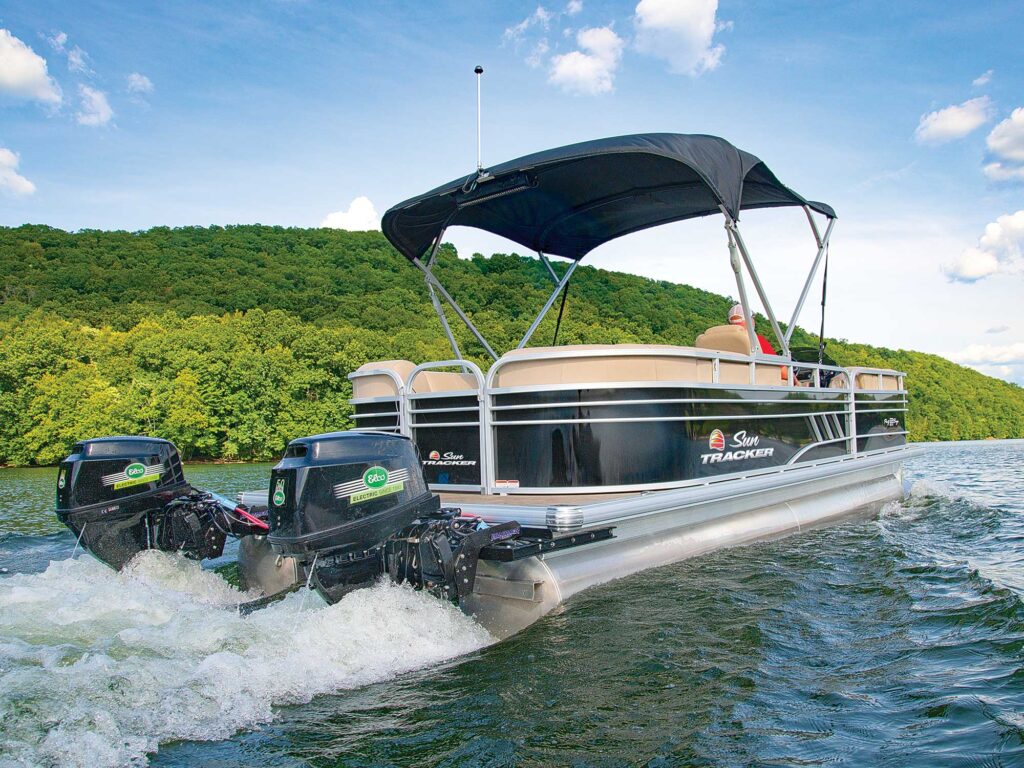
In my early days as a captain, few boats cruised faster than 30 mph. Back then, bigger engines and the fuel they burned added too much weight, netting little more speed. Today, even modest performers top 50 mph thanks to lighter engines and boat construction, where more ponies push fewer pounds.
Electric propulsion leaves boats yet again struggling in that extra-pounds paradigm. Adding fuel— measured in kilowatt-hours of lithium batteries—attenuates attempts to go faster and farther, at least until batteries become lighter. But there might be another way. I tested an electric-powered SunTracker Party Barge 22 DLX both before and after Hydrofin installed its hydrofoil system, which lifts a boat while moving through the water. This effectively overcame 800 pounds of lithium iron phosphate (LiFePO4) batteries—40 kilowatt-hours—that fueled twin Elco EP-50 electric outboards. In the end, flying on foils increased the boat’s speed by well more than a third and improved efficiency markedly. So, what are hydrofoils, and can they enhance performance aboard other boats too?
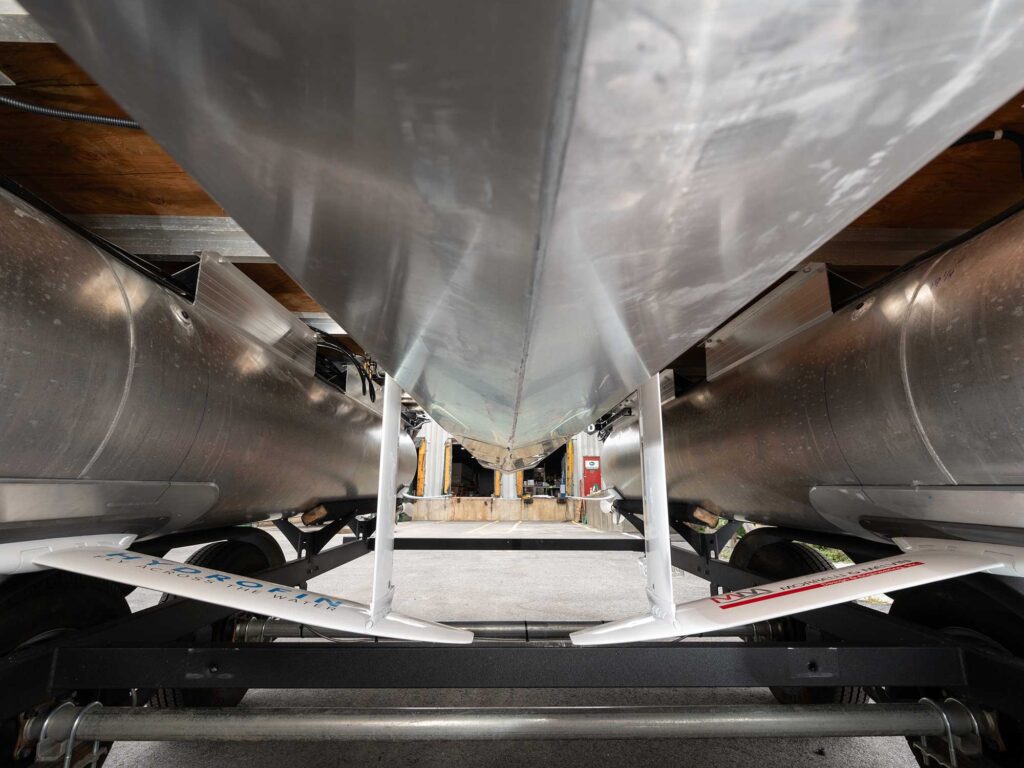
Performance Takes Flight
“We’re a long way from batteries that provide lightweight energy. Our hydrofoils create lift to overcome that additional weight,” says Jason Minor, Hydrofin’s founder. The patented system, engineered by noted catamaran and America’s Cup sailing foil-design firm Morrelli & Melvin of Newport Beach, California, utilizes powder-coated aluminum foils—essentially underwater wings. Mounting pads epoxied to hulls allow incremental adjustment of location and angle of attack, so Hydrofin foils lift nearly half a boat’s weight. “A typical bi-toon with a gas 150 runs around 30 mph. Adding Hydrofin foils can easily make it run 37 to 39 mph,” Minor says, adding that 30 percent better economy is common at cruising speeds. Riding higher on wings makes boats run smoother, dryer and quieter too. (See our Hydrofin test on a Misty Harbor 2528 pontoon with a Merc 150 hp gas outboard at boatingmag.com/hydrofin .)
Put to the Test
Hydrofin foils lifted so much battery weight that our Elco-powered test boat required larger propellers to see full improvement. Comparing performance from the final propellers, with foils removed, the boat reached 17.2 mph turning just 5,400 rpm and drawing an overloaded 67.2 kW. With Hydrofin foils installed, those same props turned 5,750 rpm to reach 24.9 mph at 58.56 kW. The original propellers, without hydrofoils, reached 6,000 rpm and 17.9 mph while consuming 49.06 kW, which we used to compute 39 percent increased speed and 16 percent improved efficiency with hydrofoils installed.
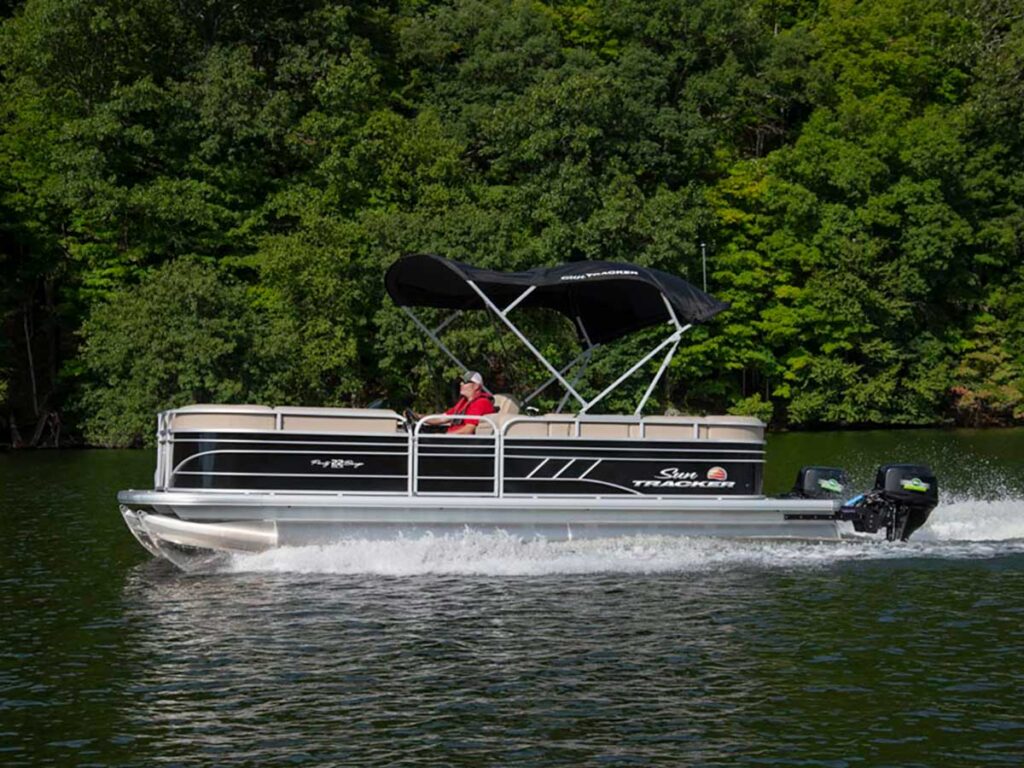
Worth the Weight
Minor says that about one-third of installations benefit from new props, which is expected when essentially lightening a boat by half. Those underwater wings alleviate passenger weight too, which often impacts gas-powered pontoon boatspeed. “A boat might lose 6 or 8 mph when full of people,” Minor says, versus carrying minimal crew. “That same boat would see just a 2 or 3 mph drop with our hydrofoils installed.”
Tri-toons, with lift from a third hull and planing strakes, tend to benefit a bit less. Minor says that gas tri-toons typically see 15 to 25 percent increase in speed or fuel economy. On a 25-foot Qwest Tri-toon powered with a prototype 350 hp equivalent Hyper Electric outboard and 1,150 pounds of batteries, Minor reported that the boat gained from 15 percent to 29 percent efficiency in the 20 to 35 mph cruising range. Hydrofin foils proved 7 percent more efficient at 43 mph, which was wide-open throttle without the foils, and they added 6 mph top speed, reaching 49 mph at the same 270 kW. (See our test of the Hyper Electric in Motorhead on page 74.)
Foil Downsides
While Minor was installing the Elco-powered test boat’s foils—about a half-day procedure—I kept an eye out for pitfalls. Foils increase draft by about 4 inches, but they’re mounted well aft of amidships, where they shouldn’t interfere at most beaches. Modifying the boat trailer’s inner bunk impacted aligning the boat back onto the trailer at the ramp, but this can be easily remedied with side guide pipes common on monohull trailers. In a hard grounding or collision, foils are engineered to break away, and Minor reports no damage to hulls or mounting pads, only foils themselves, in the few times it has occurred. Operating in very shallow water would surely be problematic, but Hydrofin’s optional electric-actuated system fully retracts well above a pontoon’s bottom.
Other Boats
Hydrofin’s system adapts to nearly all pontoon and tri-toon boats, and they’ll work on small power catamarans but not monohulls. “The foils need a gap away from the hull,” Minor explains, which comes when they’re mounted between two hulls. Hydrofin’s foils also won’t work past about 55 mph, when water flow causes foil cavitation.
Long-standing wisdom maintains that more ponies pushing fewer pounds increases speed. That’s still true, but Hydrofin shows that boats can also grow wings and fly.
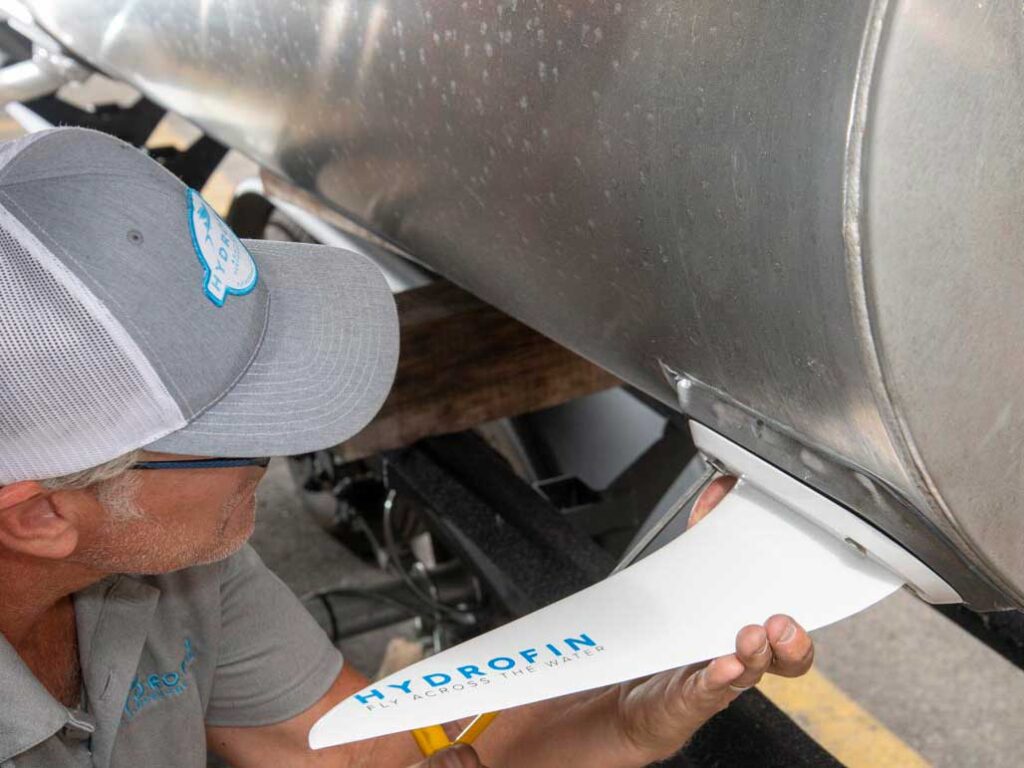
How Hydrofin Foils Attach to the Hull
On twin-hull boats, Hydrofin hydrofoils mount to pads epoxied to hulls between pontoons, with braces extending upward to the deck. Foil location and angle of attack adjust fore-and-aft trim and total lift. Finlets mounted aft add more lift to further tweak the boat’s ride and trim.
Oversize fins, chosen to carry battery weight, range from 343 to 1,822 pounds lift at 25 mph.
Tri-toons utilize a modified mount and fins that create from 537 to 1,021 pounds of lift at 25 mph, where a 25-foot Qwest tri-toon with Hyper Electric Marine’s 350 hp electric outboard was 29 percent more efficient with Hydrofin foils installed, while top speed increased by 6 mph, according to Hydrofin.
- More: April 2024 , boat building , Boats
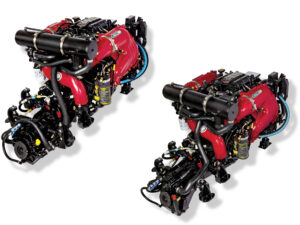
Pleasurecraft Marine’s New ZZ8R and ZZ8S Engines
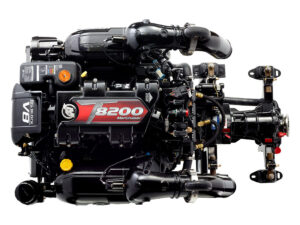
Mercury Marine Intros MerCruiser T8200 Tow Sport Inboard
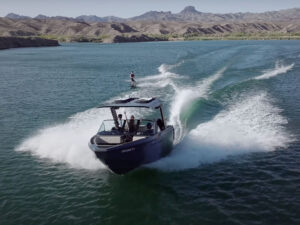
Arc Boats Optimizes Electric Power
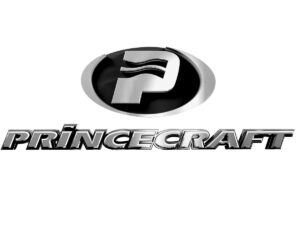
Marcel Dubois of Princecraft Dies
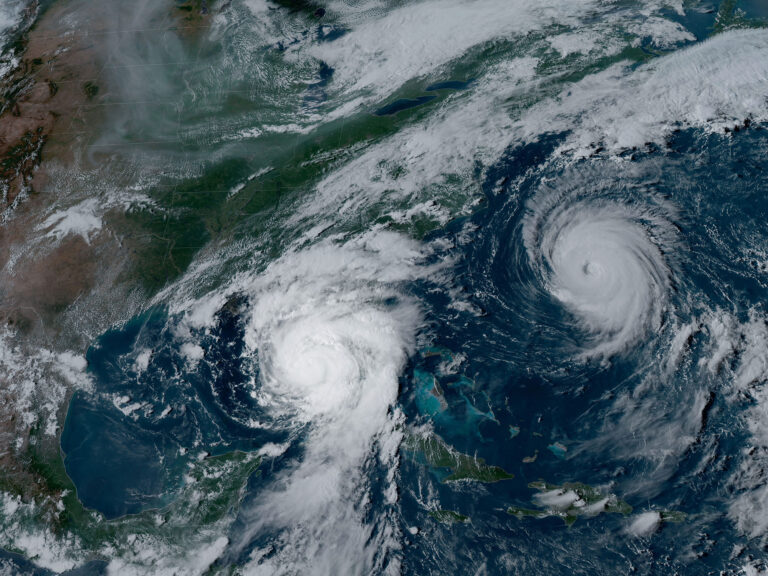
U.S. Hurricane Names Selected for 2024

After a Devastating Loss, One Family’s Resilience Leads to a Lifesaving Rescue
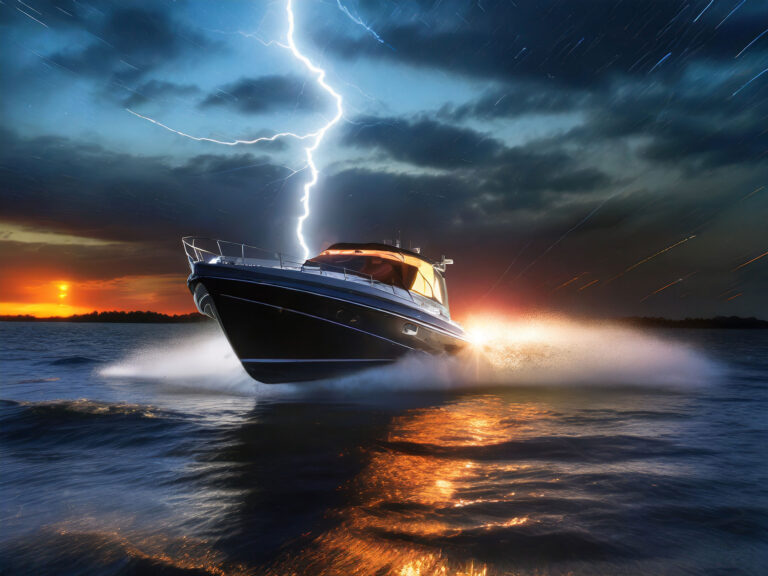
How to Avoid Lightning Strikes While Boating

- Digital Edition
- Customer Service
- Privacy Policy
- Cruising World
- Sailing World
- Salt Water Sportsman
- Sport Fishing
- Wakeboarding
Many products featured on this site were editorially chosen. Boating may receive financial compensation for products purchased through this site.
Copyright © 2024 Boating Firecrown . All rights reserved. Reproduction in whole or in part without permission is prohibited.

Support our hydrofoil educational content for free when you purchase through links on our site. Learn more
Hydrofoil Design Basics [2023]
- November 15, 2023
- Hydrofoil Basics
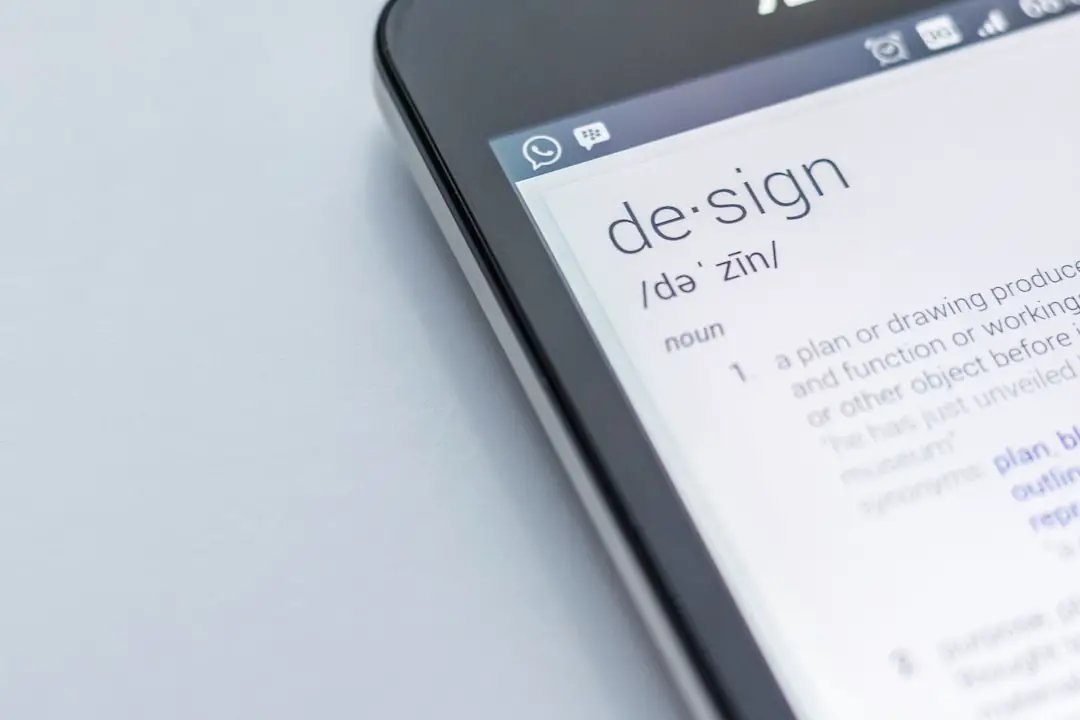
Are you ready to take your hydrofoil boarding to the next level? Understanding the basics of hydrofoil design is essential for maximizing your performance on the water. In this comprehensive guide, we’ll dive deep into the world of hydrofoil design, covering everything from the different types of hydrofoil designs to the configuration of a hydrofoil. So grab your board and let’s get started!
Table of Contents
Quick answer, quick tips and facts, types of hydrofoil designs, configuration of a hydrofoil, choosing the right hydrofoil design, hydrofoil design for beginners.
Recommended Links
Reference Links
Hydrofoil design is a crucial aspect of hydrofoil boarding. The design of a hydrofoil consists of several components, including the foil head, foil mast, fuselage, front wing, and stabilizer. These components work together to provide lift, stability, and maneuverability on the water. The type of hydrofoil design you choose will depend on your skill level, riding style, and personal preferences.
- CHECK PRICE on: Hydrofoil Boards | Hydrofoil Wings | Hydrofoil Masts
Before we dive deeper into hydrofoil design, here are some quick tips and facts to keep in mind:
- Hydrofoils are made up of several components, including the foil head, foil mast, fuselage, front wing, and stabilizer.
- Many companies offer modular hydrofoil systems, allowing riders to mix and match components for their preferred setup.
- Longer mast lengths provide more leeway for overfoiling and offer stability, while shorter masts offer zippier turns.
- Longer fuselages help with earlier takeoffs and stability, while shorter fuselages are better for maneuverability.
- There are two main types of hydrofoil wings: low aspect and high aspect. Each type has different characteristics in terms of lift, speed, and stability.
- Most hydrofoil wings are made of pre-preg carbon, which is known for its high performance. However, some brands offer alternative materials such as G-10.
- The size of the front wing surface area plays a crucial role in the performance of a hydrofoil. Larger front wings are recommended for average weight riders in moderate breeze, while smaller stature riders can get away with smaller wings.
Hydrofoil boarding has gained immense popularity in recent years, thanks to its ability to provide an exhilarating and unique riding experience. But what exactly is a hydrofoil, and how does it work?
A hydrofoil is a wing-like structure that is attached to the bottom of a surfboard, kiteboard, or stand-up paddleboard. When the board is in motion, the hydrofoil generates lift, lifting the board out of the water and reducing drag. This allows riders to glide smoothly above the water’s surface, providing a sensation of flying.
The design of a hydrofoil plays a crucial role in its performance. Each component of the hydrofoil, from the foil head to the stabilizer, is carefully engineered to optimize lift, stability, and maneuverability. Let’s take a closer look at the different types of hydrofoil designs and their configurations.
Hydrofoils come in various designs, each offering unique characteristics and performance capabilities. Here are some of the most common types of hydrofoil designs:
Low Aspect Hydrofoils : Low aspect hydrofoils have a wider wing span and a thicker profile. They provide excellent lift and stability, making them ideal for beginners and riders looking for a forgiving and easy-to-control hydrofoil.
High Aspect Hydrofoils : High aspect hydrofoils have a narrower wing span and a thinner profile. They offer higher speeds and increased maneuverability, making them popular among experienced riders who prioritize performance.
Modular Hydrofoils : Many hydrofoil manufacturers offer modular hydrofoil systems, allowing riders to customize their hydrofoil setup. These systems typically consist of interchangeable components, such as different front wings, stabilizers, and fuselages. This flexibility allows riders to fine-tune their hydrofoil to suit their riding style and conditions.
Surf-Specific Hydrofoils : Surf-specific hydrofoils are designed specifically for riding waves. They often feature larger front wings and stabilizers to provide maximum lift and stability in the surf. These hydrofoils are popular among surfers who want to take their wave riding to new heights.
Kiteboarding Hydrofoils : Kiteboarding hydrofoils are designed to provide maximum lift and efficiency for kiteboarders. They typically have larger front wings and shorter masts to generate lift at lower speeds. Kiteboarding hydrofoils allow riders to ride in lighter wind conditions and perform impressive jumps and tricks.
Wing Foiling Hydrofoils : Wing foiling hydrofoils are designed specifically for wing foiling, a relatively new water sport that combines elements of windsurfing, kiteboarding, and hydrofoiling. These hydrofoils are optimized for low-speed lift and maneuverability, allowing riders to glide effortlessly across the water using a handheld wing.
Each type of hydrofoil design has its own advantages and disadvantages. It’s important to consider your skill level, riding style, and the conditions you’ll be riding in when choosing a hydrofoil design.
To understand hydrofoil design better, let’s take a closer look at the configuration of a hydrofoil. A typical hydrofoil consists of the following components:
Foil Head : The foil head is the front part of the hydrofoil that attaches to the board. It houses the front wing and is responsible for generating lift.
Foil Mast : The foil mast is the vertical strut that connects the foil head to the board. It provides stability and allows the hydrofoil to move through the water smoothly.
Fuselage : The fuselage is the main body of the hydrofoil that connects the foil head to the stabilizer. It provides structural support and stability.
Front Wing : The front wing is the main lifting surface of the hydrofoil. It generates lift as water flows over it, allowing the board to rise above the water’s surface.
Stabilizer : The stabilizer is a smaller wing located at the rear of the hydrofoil. It provides stability and helps control the pitch and yaw of the hydrofoil.
Each component of the hydrofoil is carefully designed to optimize performance and provide the rider with a smooth and controlled riding experience. The size, shape, and material of each component can have a significant impact on the hydrofoil’s performance characteristics.
Choosing the right hydrofoil design is crucial for maximizing your performance on the water. Here are some factors to consider when selecting a hydrofoil design:
Skill Level : Beginners may prefer low aspect hydrofoils, which offer stability and forgiveness. Experienced riders may opt for high aspect hydrofoils, which provide higher speeds and increased maneuverability.
Riding Style : Consider your preferred riding style. If you enjoy riding waves, a surf-specific hydrofoil may be the best choice. If you’re into kiteboarding, a kiteboarding-specific hydrofoil will provide the lift and efficiency you need.
Conditions : The conditions you’ll be riding in can also influence your hydrofoil design choice. If you’ll be riding in light wind conditions, a kiteboarding hydrofoil with a larger front wing may be ideal. If you’ll be riding in choppy waters, a hydrofoil with a longer fuselage can provide stability.
Modularity : Consider whether you want the flexibility to customize your hydrofoil setup. Modular hydrofoils allow you to mix and match components to fine-tune your hydrofoil to your preferences.
Brand and User Reviews : Research different brands and read user reviews to get an idea of the performance and quality of different hydrofoil designs. Look for brands with a good reputation and positive feedback from riders.
Remember, the best hydrofoil design for you will depend on your individual preferences and riding style. It’s always a good idea to try out different hydrofoils before making a purchase to see which design suits you best.
If you’re new to hydrofoil boarding, choosing the right hydrofoil design is essential for a smooth learning experience. Here are some tips for beginners:
Start with a Low Aspect Hydrofoil : Low aspect hydrofoils are generally more forgiving and easier to control, making them ideal for beginners. They provide stability and lift at lower speeds, allowing you to focus on mastering the basics of hydrofoil boarding.
Consider a Longer Mast : A longer mast can provide additional stability and make it easier to maintain balance on the hydrofoil. However, keep in mind that longer masts may limit your maneuverability, so it’s important to find the right balance for your skill level.
Take Lessons : Consider taking lessons from a qualified instructor to learn the proper techniques and safety guidelines for hydrofoil boarding. A professional instructor can help you choose the right hydrofoil design and provide valuable tips to accelerate your learning curve.
Practice in Calm Conditions : Start practicing in calm, flat water conditions to build your confidence and get a feel for the hydrofoil. As you progress, you can gradually venture into more challenging conditions.
Remember, learning to hydrofoil takes time and practice. Be patient with yourself and enjoy the journey of mastering this exciting water sport.
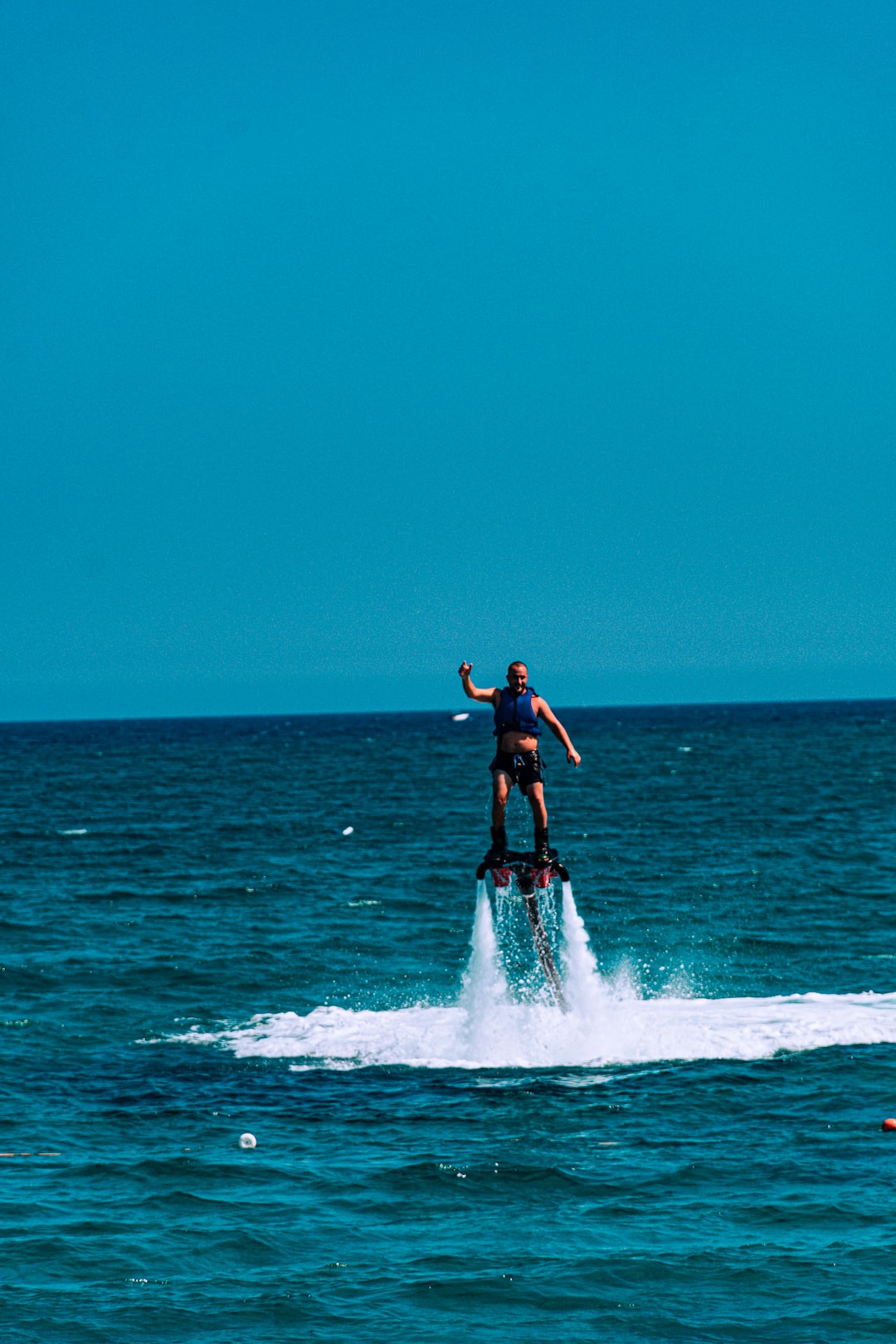
What is the most efficient hydrofoil design?
The most efficient hydrofoil design depends on various factors, including riding style, skill level, and personal preferences. High aspect hydrofoils are generally considered more efficient in terms of speed and maneuverability, but they require more skill to control. Low aspect hydrofoils offer stability and forgiveness, making them a popular choice for beginners and riders looking for a more relaxed riding experience.
What are the different types of hydrofoil designs?
There are several types of hydrofoil designs, including low aspect hydrofoils, high aspect hydrofoils, modular hydrofoils, surf-specific hydrofoils, kiteboarding hydrofoils, and wing foiling hydrofoils. Each type offers unique characteristics and performance capabilities, allowing riders to choose a design that suits their riding style and preferences.
What is the configuration of a hydrofoil?
The configuration of a hydrofoil includes the foil head, foil mast, fuselage, front wing, and stabilizer. These components work together to provide lift, stability, and maneuverability on the water. The size, shape, and material of each component can have a significant impact on the hydrofoil’s performance characteristics.
How do you hydrofoil for beginners?
Hydrofoiling for beginners requires patience, practice, and the right equipment. Here are some tips for beginners:
- Start with a low aspect hydrofoil for stability and forgiveness.
- Consider a longer mast for additional stability.
- Take lessons from a qualified instructor to learn the proper techniques and safety guidelines.
- Practice in calm, flat water conditions to build confidence and develop your skills gradually.
By following these tips and investing time in practice, you’ll be on your way to becoming a proficient hydrofoil boarder.
Read more about “How Easy is Hydrofoiling? …”
Understanding the basics of hydrofoil design is essential for maximizing your performance on the water. Whether you’re a beginner or an experienced rider, choosing the right hydrofoil design can make a significant difference in your riding experience. Consider factors such as skill level, riding style, and conditions when selecting a hydrofoil design. Remember to take lessons and practice regularly to improve your skills and enjoy the exhilarating world of hydrofoil boarding.
- Shop Hydrofoil Boards on: Amazon | Walmart | Etsy
- Shop Hydrofoil Wings on: Amazon | Walmart | Etsy
- Shop Hydrofoil Masts on: Amazon | Walmart | Etsy
- Hydrofoil Basics: Hydrofoil Basics
- Hydrofoil History: Hydrofoil History
- Advanced Hydrofoiling Techniques: Advanced Hydrofoiling Techniques
- Hydrofoil Equipment Reviews: Hydrofoil Equipment Reviews
- Hydrofoil Boat: All You Need to Know 2023: Hydrofoil Boat: All You Need to Know 2023
- McConks windSUP/windsurf/wing surf/wing foil guide – hydrofoil types …
Review Team
The Popular Brands Review Team is a collective of seasoned professionals boasting an extensive and varied portfolio in the field of product evaluation. Composed of experts with specialties across a myriad of industries, the team’s collective experience spans across numerous decades, allowing them a unique depth and breadth of understanding when it comes to reviewing different brands and products.
Leaders in their respective fields, the team's expertise ranges from technology and electronics to fashion, luxury goods, outdoor and sports equipment, and even food and beverages. Their years of dedication and acute understanding of their sectors have given them an uncanny ability to discern the most subtle nuances of product design, functionality, and overall quality.
Related Posts
What does foiling feel like [2024] ✨.
- May 15, 2024
How do you ride a hydrofoil? [2024] 🏄♂️
Hydrofoil buyer’s guide: everything you need to know [2024] 🌊.
- May 12, 2024
Leave a Reply Cancel Reply
Your email address will not be published. Required fields are marked *
Add Comment *
Save my name, email, and website in this browser for the next time I comment.
Post Comment
Trending now

- 469-587-7501

faster speeds
Improved Efficiency
a smooth, dry ride
Would you like a better boating experience?
Are you tired of getting beat up by rough water?
Does water splash over the side of your boat and soak your passengers?
Would faster speeds allow you to do more of the things you love?
Would you like to get better fuel economy and range out of each tank?
Is your boat’s performance preventing you from the watersports you enjoy?
Would you like a more comfortable and better riding boat?
Your boat is a big investment and time on the water is valuable. You deserve a better experience!

For decades, little has changed to make pontoons better riding and more efficient boats. Yes, construction materials and manufacturing methods have improved quality but the round log hull shapes are virtually the same as they were 30 years ago. Your boat may be beautiful but are you happy with the way it rides? Would you like a better boating experience?
This is why we exist and the problem we set out to solve.
- We believe that any bitoon or tritoon can be a great riding, high performing, and efficient boat.
- We believe that performance and horsepower are independent of each other… that each should be able to stand on their own.
- We believe a high performing boat doesn’t also have to be a high horsepower boat
- Rigged with Hydrofin, we believe that bitoons can perform as well as tritoons (and maybe even better).
- We believe that boating should be more affordable
- We believe the “performance problem” is being solved with big expensive motors instead of innovation.
- We believe innovation is the key and that Hydrofin hydrofoils are the future.
Here’s how it works. Just like wings lift an airplane, Hydrofin wings lift the boat to reduce drag and improve performance. Hydrofin is an engineering masterpiece designed by world champion naval architects Morrelli & Melvin. Designed to carry approximately 45% of the total weight of the boat, Hydrofin wings eliminate drag and improve ride.
Make your new boat better. Make your old boat new.
- Pick your product. Super Fly (for bitoons) or Super Ride XL (for tritoons)
- Anticipate the excitement. Products typically ship the same day. DIY self installs are quick and easy on pontoons. Professional installation is recommended for tritoons. View installation instructions and options by clicking here.
- Love your boat again. Fill up the cooler, crank up the Buffett and enjoy a new, upgraded boating experience!
“I love my Hydrofins! My boat rides so much better, even fully loaded in rough water. Since the boat lifts mostly out of the water there is less splashing and it even leans into turns like a v-bottom boat. Top speed went from 26 to 34 and the fuel economy is awesome.” -Steve R.
We’ve done the math and we’ve got the data to back it!

This graph shows a before and after comparison of a boat equipped with Hydrofin. Our hydrofoil system will create faster top speeds and improve efficiency at cruising RPMs.
leave buyer’s remorse in your wake.
Pick your product
Fill up the cooler, crank up the Buffett and enjoy a new, upgraded boating experience!

engineered for these brands and many more!

Testimonials:
High Quality products built to last
- Heavy Duty marine grade aluminum and stainless steel parts with a 5 year warranty
- Engineered to withstand impact from normal wear and tear
- Nothing to maintain. Easily replaceable parts.

(469) 716-5503
Hydrofoil Sailing
Boats That Fly
Site Navigation [Skip]
- Latest Updates
Sailboats have been using hydrofoils to fly above the water for over 50 years. However, with the advances in materials and construction, hydrofoil sailing is becoming more common. The plan for this site are to have information on many prior hydrofoil boats as well as current and future boats. There will also be other sections on upcoming events, designs and speed records.
Last update: February 2008

300 Whale Tail Hydrofoil Stabilizer

200 Whale Tail Hydrofoil Stabilizer

Dorsal Fin Style Hydrofoil Stabilizer
- Quality Statement
- Shipping Options
- Installation Guide
- Technical Manual

Boat Hydrofoil Pros and Cons: Is It Worth the Investment?
If you’re a boat owner, you’ve likely heard about boat hydrofoils and the potential benefits they can bring to your boating experience. But are they worth the investment? This comprehensive guide will explore the pros and cons of outboard hydrofoils, providing you with the necessary information to make an informed decision.
Understanding Hydrofoils
A hydrofoil is a specialized device designed to create lift when moved through water, similar to how an airfoil works in the air. The unique shape of the hydrofoil allows water to flow faster over it than underneath it, creating a low-pressure area on top. This pressure https://guardmarine.com/product/dorsal-fin-style-hydrofoil-stabilizer/ difference generates lift, raising the boat’s hull above the water and significantly reducing drag.

The Science Behind Hydrofoils
In simple terms, a hydrofoil works by manipulating the flow of water around it. As the boat moves forward, water flows over the hydrofoil, creating a pressure difference that lifts the boat. This reduces the amount of hull in contact with the water, thereby reducing drag and allowing the boat to move faster and more efficiently.
The Pros of Boat Hydrofoils
There are several benefits to installing a hydrofoil on your boat, including:
Enhanced Boat Performance and Speed
The primary advantage of hydrofoils is their ability to improve a boat’s performance. By reducing water resistance, hydrofoils allow your boat to move faster. This effect is particularly noticeable on smaller boats with outboard motors, such as fishing or leisure boats.
Improved Fuel Efficiency
Hydrofoils can also enhance your boat’s fuel efficiency. By reducing drag, your boat’s engine doesn’t have to work as hard, leading to less fuel consumption. This means you can enjoy longer trips without worrying about refueling.
Increased Stability
Hydrofoils can significantly improve your boat’s stability, providing a smoother ride even in rough waters. This is due to the balance and stabilization that hydrofoils provide, even at high speeds.

Enhanced Safety
Hydrofoils can also enhance safety by eliminating issues like low bow rise, cavitation, porpoising, prop ventilation, and chine-walking.
The Cons of Boat Hydrofoils
Despite their numerous benefits, hydrofoils do have some limitations:
Limitations for Large Boats
Hydrofoils are not recommended for large boats or ships as the benefits won’t be as significant.
Prone to Damage
Hydrofoils are prone to damage from repeated impacts, which could lead to steering issues or accidents.
Frequently Asked Questions
Does boat size matter when purchasing a hydrofoil.
Yes, boat size does matter. While some hydrofoils are suitable for larger boats, most are best suited for small to mid-sized boats.
Can Bumps Damage a Hydrofoil or Cause it to Fall Off?
While hydrofoils are made from durable materials, a significant impact, such as hitting a rock, could cause the hydrofoil to fall off.
In conclusion, the benefits of installing a hydrofoil on your boat include improved speed, efficiency, and stability. However, it’s important to consider their limitations before making a purchase. By understanding the outboard hydrofoil pros and cons, you can make an informed decision that best suits your boating needs.
Related Post

Hydrofoil Stabilizers: Revolutionizing Marine Speed and Efficiency
- 9 7 月, 2023
- Category: Hydrofoil Stabilizers , Related Topic

What Is a Hydrofoil for an Outboard?
- 26 7 月, 2023
- Category: Hydrofoil Stabilizers

Common Misconceptions About Hydrofoils for Outboard
- 15 7 月, 2023
Contact Us Today, Get Reply Tomorrow
Your information will be kept strictly confidential.

I am Evelyn, the sales service manager of Guard Marine, me and my team would be happy to meet you and learn all about your business, requirements and expectations.

- FlySafe ® Foil Control
- iFLY Reviews
- Our Partners
- Distributors
- Class Association
Enter your keyword

“iFLY15 is the unique combination of high performance with easy accessibility – for maximum performance and maximum fun.”
Cec catamarans -ifly15 team, “we love speed while keeping control – high speed needs to be controllable. the flying boat of the future, is a stable foiling sport catamaran.”, cec catamarans – ifly15 team, „ foiling: one of the things you have to experience to really feel it. “, jimmy spithill, skipper oracle team usa, “stable flight is the key to high performance sailing”, “ifly15 – get the balance right between a nice sporting challenge and a reasonable and controllable level – enjoy the exhilaration, the speed and the adrenaline in your veins, but always stay master of the situation “, “stable flight attitude is the most important prerequisite for high performance sailing.”, victor diaz de leon, sailgp team usa, “stable flight attitude is key for easy foiling. ifly15 with superior flight stability delivers immediate flying fun within the first minutes. advantage through high-tech.”, “the ifly15 is the quickest boat around the course, … “, arno terra – sailor, ifly 15 one design and ifly razzor pro, the performance foiling catamaran, for maximum speed and maximum control.
- Easy access to a high HIGH PERFORMANCE FOILING CATAMARAN
- Automated DYNAMIC FLIGHT Assistance SYSTEM – FLYSAFE® FOIL CONTROL
- highest quality standards – High-tech full carbon sailboat
- completely modular – fully customizable
- adjustable rake – MAIN FOIL DIFFERENTIAL during sailing for even more performance in the version IFLY Razzor Pro
- Foiling Versatility and Speed …
The quality and performance have been proven for 8 years and further developed to maximum perfection in every detail
IFLY HYDROFOIL SAILING – EXCELLENCE, FIELD PROVEN TO PERFECTION
Racing and more …..
Have a high performance racing machine on regattas
single handed or double Foiling
crew weight up to 180 kg
Racing and fun:
Sail with Family & friends
in any sailing condition:
Full foiling – upwind and downwind
Waves and Flat waters
Light and strong winds
early take off
Foiling maneuvers
Transport and Facilities
Easily transportable on a road trailer
Slipped with a conventional beach trolley
ready to sail in 20 minutes
iFLY15 is designed to sail on the sea and lakes
Stay tuned for foiling events and specials!
Flysafe® Flight assistance
Main foil differential technology – mdt, innovative, sophisticated foil control for unbeaten performance, high speeds and easy access, ifly15 and ifly razzor pro, ifly main foil differential – mdt, ifly razzor pro.
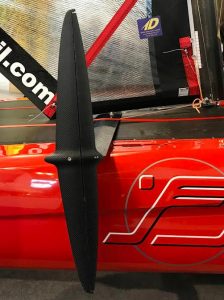
early take off in lightest breeze
F oiling maneuvers are heavily supported, superior flight attitude through active foil control, dynamic control of f light high , pitch and role, non-linear control and feedback control system for best flight stability, even in waves, the foils do not need to be manually manipulated, optimized performance: advanced sailors can adjust rake and gearing, more about flysafe®>>>, active flight assistance, the foil can be trimmed actively while sailing, the key to maximum performance , mdt for performance-orientated pro sailor, mdt extends the flysafe® foil control, to sail large xxl rigs, more about main foil differential ->>>, performance downwind: staying on the foils, full foiling, in 5-6kts tws, reaching max. boat speeds of up to 2.5*tws, performance upwind: full foiling from 8kts. tws, taking off from 7kts tws, video youtube channel, ifly15 foiling catamaran.

The most innovative development in foiling technology
About ifly15, stable flight is key for both: first for highest performance and foiling in a wide wind range, including rough and wavy conditions, but also easy access into foiling…...
iFLY stands for uniqueness in design and function. Its superior Flysafe ® active foil control system autonomously supports the stable horizontal flight position in the longitudinal and lateral direction. The 4 T-Foils do not have to be operated by the sailor during sailing.
Average skilled dinghy or catamaran sailors with some trapeze experience can safely foil with the iFLY15 after only a few hours. Quick access – the immediate sensation of success – steep learning curve. In the hand of an experienced sailor, iFLY15 offers a whole new sailing experience with previously not experienced speeds and agile maneuverability.
The flight control system, combined with numerous fine-tuned innovations , ensures safe foiling even in strong winds and rough seas.. Stable flight attitude allows pushing hard, so in good conditions, iFLY reaches high boat speed beyond 30 knots in a controllable way.
IFLY15 offers freedom to fly alone or in pairs. Due to the exclusive use of high-tech materials , iFLY15 is extremely rigid and weighs less than 90 kilos ready to sail. With its low weight and its state-of-the-art hydrofoils, it is airborne in winds as low as 2Bft. / 6 Knots.
iFLY15 has a length of only 15 feet, is easy to transport, quick to get ready to sail, and can be easily slipped from the beach using a conventional beach trolley.
Its sophisticated design reflects the highest demands on quality and function.
iFLY15 – customer reviews
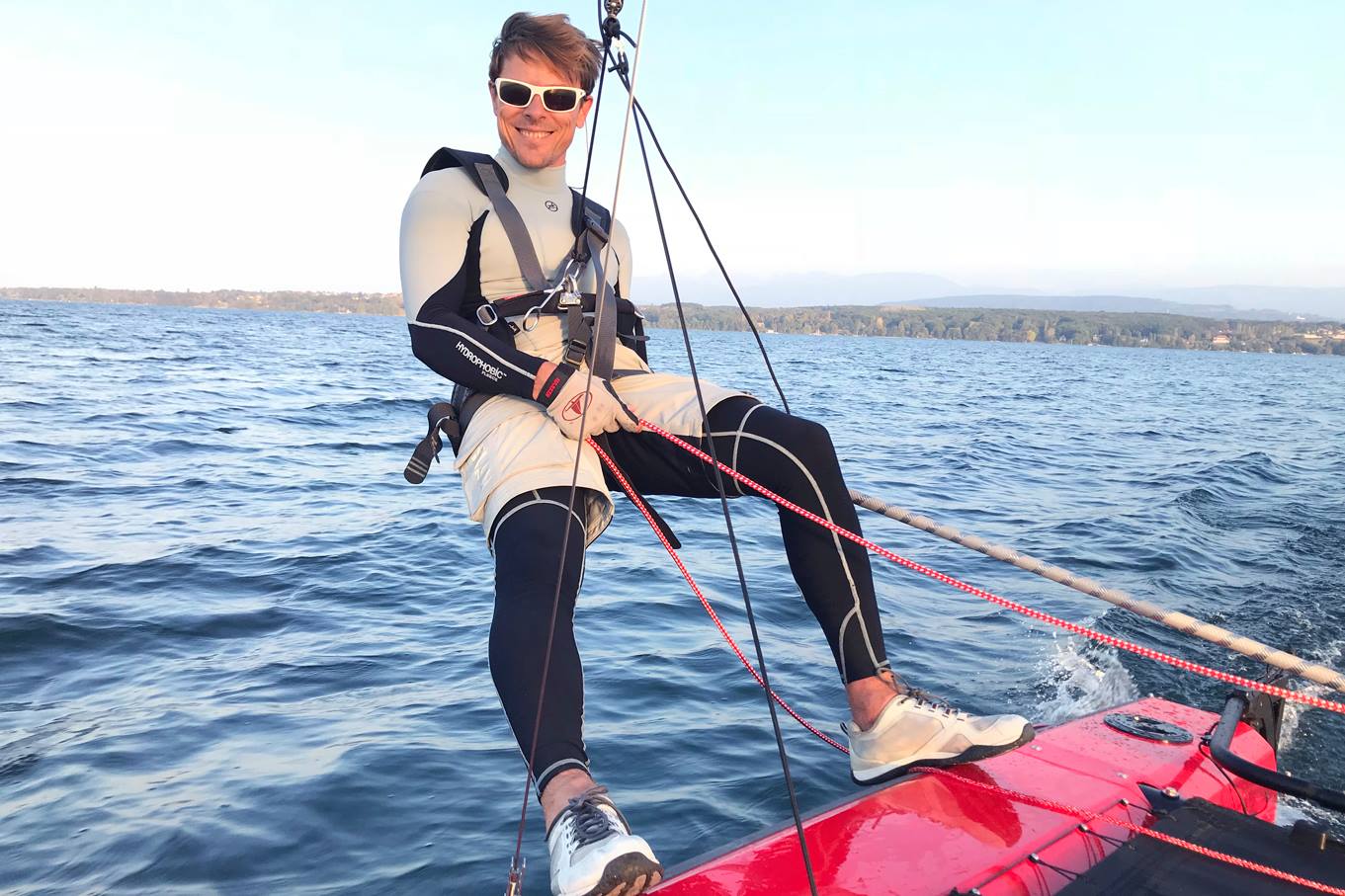
« LESS CRASHING IS MORE FUN »
MARCUS LYNCH, PROFESSIONAL SAILOR AND OLYMPIC COACH, GC32 OMAN, NACRA17
« I WAS INITIALLY AMAZED AT HOW EASY TO HANDLE THE IFLY IS AND AT HOW IDLE THE BOAT IS EVEN IN STRONG WINDS. »
ANTOINE, IFLY OWNER FROM GENEVA
VERY STABLE, EXTRAORDINARY STABLE. IT IS EXTREMELY INTERESTING, BECAUSE YOU IMMEDIATELY SEE THE ACCESSIBILITY OF THE BOAT.
FRANÇOIS GABART
« GREAT BOAT, LIKE A MOTH ON STEROIDS ! »
VICTOR DIAZ DE LEON, MIAMI, PROFESSIONAL SAILOR. US TEAM SAILGP, INTERNATIONAL MOTH, MATCHRACING MELGES 32, J70
WHAT A GREAT BOAT THIS IS, AND I ABSOLUTELY LOVE IT”
PHILIP WALKER
« THE DYNAMIC FLIGHT CONTROL SYSTEM ALLOWS LONG AND STABLE FLIGHTS »
GERHARD FLORIN, IFLY OWNER FROM GENEVA, SWITZERLAND
TO FELLOW SAILORS WHO LOVE THE THRILL OF SAILING WITH SPEED WHILE MAINTAINING CONTROL”
ROY BALLENTINE
« WELL BALANCED AND RAKE DIFFERENTIAL ALLOWING FOR GREAT PERFORMANCE UPWIND! »
CARLOS ROBLES,PROFESSIONAL SAILOR 49ER, PALMA DE MALLORCA
« A SENSATIONAL FOILING EXPERIENCE. THE SPEED IS IMPRESSIVE »
INGMAR WARNICKE: COMMODORE OF YCSO, YACHT CLUB SCHARBEUTZ, BALTIC SEA
⭐ ⭐ ⭐ ⭐ ⭐

IFLY RAZZOR PRO – THE NEW IFLY FOR EXPERIENCED SAILORS
THE SINCE 7 YEARS PROVEN IFLY15 WITH FLYSAFE® DYNMAMIC FOIL CONTROL has now a pur Racing fellow: THE iFLY RAZZOR Pro. THE iFLY racing VERSION ENABLES EVEN HIGHER PERFORMANCE, to sail in extremely tough conditions and allows sailing with XXL rigs. THE MAIN DIFFERENCE BETWEEN THE IFLY15 ONE DESIGN AND THE IFLY RAZZOR PRO IS A BIGGER RACING RIG, SPECIAL FOILS AND THE MAIN FOIL DIFFERENTIAL (MDT), WHICH IS MANUALLY TRIMMED BY THE SAILOR. THE MDT IS WORKING HAND IN HAND WITH THE FLYSAFE® DYNAMIC FOIL CONTROL SYSTEM.
flying – sailing – Blog
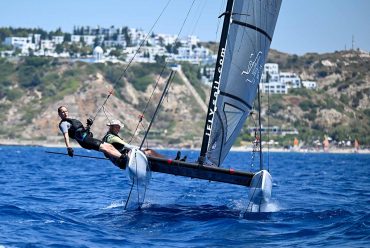
“We’re taking off! Foiling is THE Watersports Trend! – „Boot International 2024“ in Düsseldorf / Germany once again showcases: Foiling is THE trend in watersports.
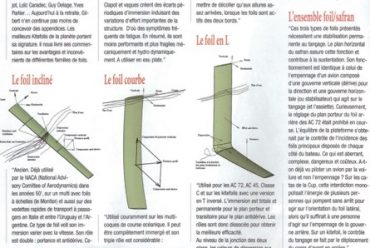
Performance Sailing – Sail GP News: Racing on the Edge – T-Foil proves to be the winning design

Regatta and foiling News: Long distance Race – Duc d’Albe 2023 – Club Multicoques Hyères – sailing Race @iFLY Razzor Pro
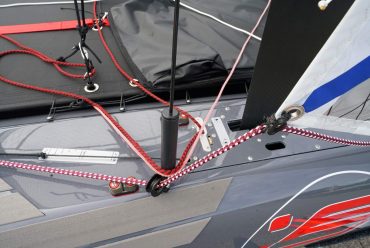
iFLY Main Foil Differential Technology – MDT Foil Control – high Performance sailing
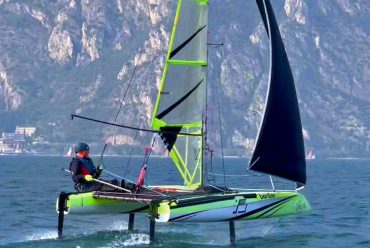
IFLY FOILING Adventure
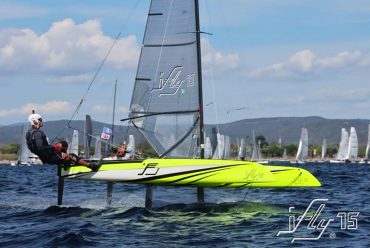
FOILING – REGATTA – EVENTS
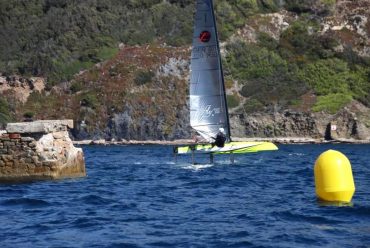
Long distance Race – Duc d’Albe 2021 – Club Multicoques Hyères – sailing Race @iFLY Razzor Pro
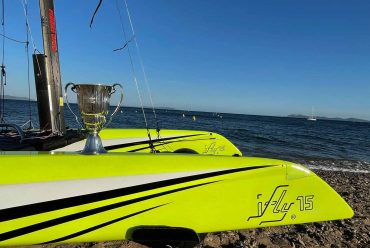
INTERNATIONAL IFLY foiling FLEET RACE 2021

iFLY15 successfully crossing the English channel / world record Attempt Cowes to Dinard / Saint Malo
Catamaran europe central, the iflysail team, is looking forward to your message.

- Subscribe Now
- Digital Editions

Best hydrofoil boats: 6 of the most spectacular foiling motorboats money can buy
- Electric boats
- Top stories
Foiling technology has really taken off in the past few years. We pick out 6 of the best hydrofoil boats you can buy right now…
With its roots in the 19th century, foiling technology is as old as the hills, but in the past five years we’ve noticed an explosion of hydrofoil boats coming onto the market.
In part inspired by the foiling raceboats of the America’s Cup , the popularity of foiling is easy to understand – fuel efficiency gains are substantial, noise is almost eliminated (particularly if your foiling boat also happens to be an electric boat ) and they look as cool as a snowman in a freezer!
To help you understand the dizzying array of foiling boats available right now, we’ve put together the following guide to what we think are the most promising designs out there.
6 of the best hydrofoil boats

SEAir foiling RIB
Founded in 2016, French yard SEAir builds foiling RIBs, having been inspired by the speed of foiling racing yachts.
We tested their 5.5m model back in 2018 and since then they have expanded their range to cover superyacht chase boats, commercial and military vessels.
Our tester recorded a top speed of 32 knots, with the foils doing their best work at around 20 knots, but SEAir claims that 42 knots is possible in the right conditions.
Read more about the SEAir foiling RIB
Article continues below…
Spirit Yachts launches spectacular long-range electric flying boat
Bmw launches new icon electric boat at cannes film festival.
The Cannes Film Festival has seen the launch of the new ICON electric boat. Created by BMW in collaboration with

A dual helm set-up allows the boat to be piloted from the bow or the cockpit. Photo: Guillaume Plisson
Enata Foiler
Dubai-based Enata Marine added a healthy dose of glamour to the world of foiling boats in 2018 with the launch of its Foiler.
In addition to a superyacht tender-worthy exterior, this 32fter includes a bow window for spectacular views while underway.
A 40-knot top speed and a 190nm range makes this a very appealing option, although the premium price tag of $938,000 may put some off.
Read more about the Enata Foiler

Princess R35
When British boatbuilding giant Princess Yachts got in on the foiling boat game in 2019 with a 35ft carbon-fibre dayboat, we knew that things had really taken off.
While the foil-assisted R35 may not have the spectacular cruising-above-the-waves appeal of some other foiling boats, it is highly efficient, beautifully designed (in collaboration with Pininfarina) and handles like nothing else we’ve ever driven.
In our review, we praised its rare combination of agility, refinement and stability, with spray kept in check impressively at high speeds.
Read more about the Princess R35

The foiling Candela C-8 is the first boat to use Candela’s proprietary C-POD, but bigger craft will follow later
Candela C-8
Swedish firm Candela burst onto the scene in 2021 with its debut, the Candela C-7 , which was billed as the world’s first electric foiling boat, but it was the 2022 launch of the Candela C-8 that really moved the game on.
Available with a 69kWh battery, adapted from the Polestar 2 electric car, owners can expect a range of 57nm at 22 knots, more than enough for dayboat use.
The consumption figures are truly staggering, with Candela’s figures suggesting that the C-8 is more than 12x more efficient than an equivalent 300hp outboard powered sportsboat.
Read more about the Candela C-8

The electric Iguana is capable of three knots on the land and 30 knots at sea
Iguana Foiler
Not content with being at the forefront of the amphibious boats market with its caterpillar-track offering, French yard Iguana has set its sights on the world of foiling too.
Announced last year, the Iguana Foiler will be powered by the world’s most powerful electric outboard engine, the 300hp Evoy Storm .
Having tested both the engine and the boat separately, we can’t wait to see the result when they come together with the added advantages of foiling technology. Watch this space…
Read more about the Iguana Foiler

The foils lift up at slow speeds to reduce the draft
Mantaray M24
Another exciting model in the hydrofoil boats pipeline, this 24ft runabout is particularly interesting is its simplicity. Unlike its main foiling rival, the Candela C-7, the Mantaray M24 requires no complicated electronics to ‘fly’.
Instead it uses the builder’s patented mechanical hydrofoil system, which it has trademarked as Dynamic Wing Technology or DWT. The technology is said to be the result of ten years’ development work and uses a retractable T-foil in the bow and H-foil amidships that self-stabilise mechanically.
This allows it to lean naturally into corners and ride serenely over waves without relying on a network of sensors and algorithms to monitor and adjust the foils. If it proves effective this could drastically reduce the cost and complexity of foiling boats, while simultaneously increasing reliability.
Read more about the Mantaray M24
It doesn’t end here, with fascinating one-off projects from Spirit Yachts and BMW on the water, it’s clear that foiling has a huge potential for transforming the world of boating.
Read more about hydrofoil technology
What we know so far about Enata’s designer foiling motor boat, Vatoz
Project 821: the world’s first hydrogen-powered superyacht will, aquila 50 yacht first look: new design, fresh direction, latest videos, bluegame bgm75 sea trial: the €6.8m powercat that thinks its a monohull, cormate chase 32 tour: fast, stylish and practical weekender, axopar 29 sea trial: sun top vs cross cabin – which is best, sunseeker ocean 182 – see how this compact superyacht copes in a wet and windy sea trial.

- Engine_Fuel & Props
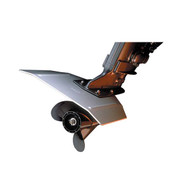
Davis Whale Tail XL Stabilizer
Davis Whale Tail XL Stabilizer The Davis Whale Tail XL is an aluminum stabilizer and ski boat fin. With this stabilizer, you can improve the performance in any I/O or outboard motor. The Whale Tail XL extends out behind the propeller to utilize prop...

Stingray Hydrofoil Boat Stabilizer
Stingray Hydrofoil Boat Stabilizer Boat rolling is caused by wave action. Boat stabilizers greatly reduce the rolling motion of boats and ships. Stingray Hydrofoil Stabilizer fins are inexpensive yet highly effective in checking roll in fishing boats,...

Davis Doel-Fin Boat Stabilizer Fin
Davis Doel-Fin Boat Stabilizer Fin Doel-Fin is the original hydrofoil developed by an aeronautical engineer to improve overall performance on all boats with outboard motors or outdrive units. Molded in two pieces of guaranteed unbreakable, high-strength...

Stingray Junior Hydrofoil Boat Stabilizer
Stingray Junior Hydrofoil Boat Stabilizer The Stringray Junior Hydrofoil was designed to satisfy the market demand for a versatile hydrofoil capable of fitting engine sizes as small as 9.9 HP that are found on inflatables, smaller tenders, and jon boats...
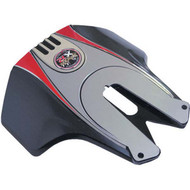
Stingray XRIII 500 Hydrofoil Boat Stabilizer
Stingray XRIII 500 Hydrofoil Boat Stabilizer The StingRay XRIII has been replaced by the StingRay XR4. [Click Here] to shop now. The StingRay XRIII Hydrofoil was designed to utilize the torque tab or sacrificial anode to secure the hydrofoil to the...

Stingray XR4 Hydrofoil Boat Stabilizer
Stingray XR4 Hydrofoil Boat Stabilizer Improve your boat's lift and holeshot with the StingRay XR4 Hydrofoil. The XR4 is designed to provide maximum lift, blast boats out of the hole quicker than ever before, and keep boats on plane at lower speeds. The...

Stingray Classic Pro Hydrofoil
Stingray Classic Pro Hydrofoil Boat Stabilizer The StingRay Classic Pro Hydrofoil has been technologically refined to enhance performance while minimizing installation effort. This boat stabilizer features expansive wings the provide maximum lift and...

Stingray Torque Equalizer-Black
Torque Equalizer attaches to any Sting Ray and Sting Ray Junior Hydrofoil Stabilizer to neutralize propeller steering torque. Performs like miniature rudders helping boat track straight & minimizing propeller's natural pull to the right. Reduces...

Stingray Stinger Hydrofoil
Stingray Stinger Hydrofoil The Stingray Stinger Hydrofoil offers maximum performance with its latest design and styling. It is designed to provide significant lift to smaller boats and engine setups while providing larger boats and engine setups with...

Stingray AIRO Hydrofoil 2-Piece Boat Stabilizer
Stingray AIRO Hydrofoil 2-Piece Boat Stabilizer The Stingray AIRO Hydrofoil is a versatile, 2-piece hydrofoil capable of fitting engine sizes as small as 4 HP while still benefiting larger engines. This economical hydrofoil can be used with engines...

Stingray Starfire Hydrofoil
Stingray Starfire Hydrofoil The Stingray Starfire Hydrofoil is designed to enhance stabilization while on the plane through extending its wing tips. It is built to reduce drag and maximize top-end speed by inverting its trailing edge. With a simple and...

Stingray Classic 2 Senior Hydrofoil
Stingray Classic 2 Senior Hydrofoil The Stingray Classic 2 Senior Hydrofoil offers three levels of lift while fitting mot 40 - 300HP outboards/sterndrives. The drag reducing wing texture helps reduce drag while offering improved holeshot to get on plane...

Stingray Hyperfoil 500
Stingray Hyperfoil 500 The Stingray Hyperfoil 500 is designed to provide vertical lift and unrestrained top-end speed. Its patented no-drill technology requires zero holes for installation and its proprietary hyperspeed red material reduces drag while...
Boat Hydrofoils
Hydrofoils or Whale Tails, are a device that attaches to your outboard or out drives cavitation plate that provides lift at the stern of the boat which brings the bow of the boat down. This action is crucial to getting your boat up to plane quicker. Not only does this save you time and gas but it also increases overall speed. Hydrofoils are especially beneficial to small outboard motors as usually these units do not have power trim and have a very small cavitation plate and do not provide much lift.
Porpoising is a condition in which a boat will "bounce" while underway. The use of a hydrofoil will help eliminate this condition as it forces the bow down at all times. The other benefit of a hydrofoil is the gas savings it can provide. This is possible by getting the boat up on plane quicker and sometimes higher so there is less contact with the water. Large horsepower outboards can also benefit from the use of a hydrofoil as well. The power trim result is exaggerated and needs less movement to achieve the same result. An outboard hydrofoil is a great investment that will provide a better ride for all boat styles and sizes.
Wholesale Marine carries boat hydrofoils from brands you can trust like Davis Instruments and Stingray . Want to learn more about how a hydrofoil can benefit your boat? Read our blog article: Boating Basics: What is a Hydrofoil ? If you have any questions about our selection, contact us at 877-388-2628 Monday through Friday from 9:00 AM to 6:00 PM. We offer same-day flat rate shipping. Make sure to inquire about our Captain’s Loyalty Program for additional savings on future purchases.
Subscribe to our Newsletter
Get the latest updates on new products and upcoming sales
Oops, something went wrong. Please try again.
You are now logged in!
Electric boats
Electric hydrofoil, meet vessev and its ultra-efficient electric hydrofoil boat designed for smooth tourist rides.
A new all-electric maritime specialist called Vessev has come out of stealth mode with an exciting new vessel called the VS—9. The electric hydrofoil boat offers a state-of-the-art design that delivers incredible efficiency, providing future tourists with a smooth and quiet ride as Vessev looks to commercialize into larger vessels that can transport 100 passengers at a time.
Vessev, formerly known as Seachange, is a young, eco-friendly boat builder founded a few years ago by two bright minds with backgrounds in innovation, including a tenure at Apple. The company was founded in Auckland, New Zealand, where it currently operates and is conducting sea trials of its flagship vessel—an electric hydrofoil boat called the VS—9.
Designed for commercial operations and tourism, this electric hydrofoil “flies” above the water, offering a new futuristic option in sea travel that will soon be used as a passenger ferry thanks to NetZero Maritime – the green technology team at Fullers360 – New Zealand’s largest ferry operator, who has already signed on to help commercialize the hydrofoil technology.
But that’s not all. Vessev may be young, but it has a clear vision for the future of clean maritime transport, and the VS—9 is merely its starting point for larger electric hydrofoil boats and more scaled deployments. Per Vessev co-founder and CEO Eric Laakmann:
We are in the earliest stage of a global transition to sustainable energy use. Our partnership with NetZero Maritime is one of the most powerful in the world in accelerating the adoption of new technologies. There are 33 million vessels in the world today with sustainable vessels representing the smallest fraction. Through significant enhancements in efficiency, hydrofoiling will play a key role in this once-in-a-generation shift.
Vessev’s entry into cleaning up and potentially revolutionizing the maritime segment begins with the VS—9 electric hydrofoil, which has made its public debut and will soon be certified for commercial operations overseas. Have a look.
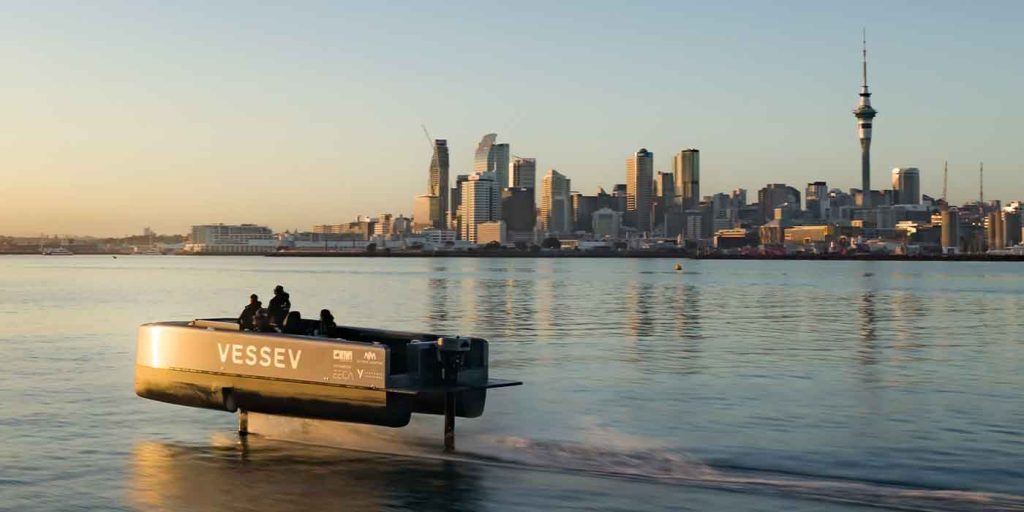
Vessev looks to expand to larger electric hydrofoil boats
The maritime developer shared details of its flagship electric hydrofoil boat this week as it came out of stealth mode with some impressive in-house technology, encouraging performance specs, and a detailed plan for its expansion into commercial ferry operations and beyond.
The VS—9 was designed using the same state-of-the-art foiling technology used in the America’s Cup (the oldest international competition still operating in any sport) to maximize efficiency and range by foiling above the water. Vessev shared that its electric hydrofoil boat technology reduces energy consumption by up to 95%.
This technique not only enables the vessel to travel farther on a charge due to less impact from waves and wake but also delivers a smoother ride for passengers. Add the quietness of an all-electric motor, and you get a new breed of boat that feels like the ideal way to travel across water.
The new electric hydrofoil boat offers room for ten passengers and can travel at a service speed of 25 knots (~29 mph). The VS—9 has a range of 50 nautical miles (57 miles/92.6km) and can recharge its batteries at any marina plug. If that area happens to have a DC fast charger, Vessev says the VS—9 can recoup 0.8 nautical miles of range per minute.
The VS—9 is undergoing sea trials out of Auckland, and its initial tests have been encouraging. Laakman explained:
We use techniques similar to America’s Cup vessels which provide very high control authority when compared to other systems. That means we can handle more wind and bigger seas. The system is more difficult to engineer up-front, but results in a very performant vessel that is both more capable and more efficient. The VS—9 is so efficient that we are able to use very safe and longer-lasting battery technologies when compared to other vessels of this type. To put it into perspective, the VS—9 is undergoing on-water testing with a petrol-powered chase boat following, doing the same motions and distance. At the end of each day, the cost of the petrol fueling the chase boat is 25 times the cost of the electricity used to charge the VS—9.
Vessev is seeking certification later this year, with commercial operations carried out by Fullers360 in New Zealand thereafter. In addition to the ten-passenger VS—9, Vessev shared that it is already working to scale its technology into larger electric hydrofoil boats, including a new 100-passenger vessel called the VS—18. According to the company, that hydrofoil will have “additional seakeeping capability and unlock even more opportunities.”
FTC: We use income earning auto affiliate links. More.


Scooter Doll is a writer, designer and tech enthusiast born in Chicago and based on the West Coast. When he’s not offering the latest tech how tos or insights, he’s probably watching Chicago sports. Please send any tips or suggestions, or dog photos to him at [email protected]

Manage push notifications


IMAGES
VIDEO
COMMENTS
Shop Our Huge Selection of Stingray Hydrofoils & Stabilizers at the Lowest Prices Online.
Italian Enrico Forlanini began experimenting with foils in 1898. In 1906, his 1-ton 60 hp foiler reached 42.5 mph. Alexander Graham Bell's HD-4 Hydrodrome flew on Bras d' Or Lake at 70 mph in 1919. And several sailing foiler patents began appearing in the 1950s. Notably, JG Baker's 26-foot monohull, Monitor, flew at 30-plus mph in 1955.
Quick Answer: A hydrofoil yacht is a sailboat equipped with wing-like foils that lift the hull out of the water as it gains speed. This reduces drag, increases speed, and provides a smoother ride. Hydrofoil yachts can be retrofitted on both monohull and multihull sailboats, with different types of foils used for stability and control.
Being the biggest boat in the field means that I will have a speed disadvantage over the pack of smaller boats. Having the StingRay HyperFoil 500 on my boat makes up a lot of that disadvantage by putting me on plane before the lighter boats, and allowing me to reach my top speed even faster. It also allows me to run in shallower water.
Then friction only acts on the small foils, not on the whole hull, which is why a 130-foot hydrofoiling sailboat can "fly" at over 50 knots. Powerboats have added friction from the propulsion system that has to remain in the water, but even then, large hydrofoiling ferries can exceed 45 knots. Speed is not the only advantage that hydrofoils ...
Hydrofoiling wingsail catamaran 17. A sailing hydrofoil, hydrofoil sailboat, or hydrosail is a sailboat with wing-like foils mounted under the hull.As the craft increases its speed the hydrofoils lift the hull up and out of the water, greatly reducing wetted area, resulting in decreased drag and increased speed. A sailing hydrofoil can achieve speeds exceeding double and in some cases triple ...
Hydrofoils that lift a hull entirely out of the water seem to be too alien to most boaters. Plus, most foil designs require dynamic control using computers to remain aloft at a constant elevation. But they are proven to be effective. ... On this boat, little trim is needed because the optimal angle of attack of the hydrofoil is only about 1.5 ...
Ongoing innovations in foil technology continue to propel hydrofoils to new heights. ... Discover the Magic of Hydrofoil Sailboats. Hydrofoils saw their early development as a concept for enhancing speed and efficiency on the water. From Alexander Graham Bell's experiments to the application of foils on sailboats in the 1950s, the quest has ...
The foils on the new America's Cup boats are more accurately called hydrofoils, because they work in water. The secret to both types of foil is the shape - aerofoils and hydrofoils use a ...
Supported by an electric propulsion system and automatically actuating hydrofoils, this has become one of the most popular hydrofoil boats on the market. Price: $240,000. Power Specs: 40 hp, 40 kWh battery, capable of cruising at 22 knots. ** For a more in-depth review, check out this Youtube video: Candela C-7 Review.
January 18, 2023. The foiling revolution is taking hold—and is coming to far more than just sailing yachts these days. Kevin Rio/69F Media. There's a revolution underway in the sport of sailing, and it can be summed up in one simple word: foiling. More specifically, we're talking about hydrofoils, the winglike appendages mounted beneath ...
Foiling refers to the use of hydrofoils attached to the hull of fast boats, which provides additional lift at planing speeds - often enough to lift the hull completely clear of the water. ... British boat designer John Thornycroft followed up with a series of scale models featuring stepped hulls and a single foil, and by 1909 had a full-scale ...
The original propellers, without hydrofoils, reached 6,000 rpm and 17.9 mph while consuming 49.06 kW, which we used to compute 39 percent increased speed and 16 percent improved efficiency with hydrofoils installed. The Hydrofin foils added 7 mph top speed and increased efficiency by 16 percent aboard this 22-foot SunTracker with twin Elco EP ...
With razor-sharp hydrofoil catamarans that help them hit speeds of 60 miles an hour, the athletes of SailGP are pushing the limits of physics and human endur...
Hydrofoil boats work on the principle of hydrodynamics. The hydrofoils, which are typically located beneath the hull, generate lift as the boat gains speed. This lift raises the hull out of the water, reducing drag and allowing the boat to glide smoothly above the surface. The hydrofoils themselves are wing-like structures with a curved shape.
Hydrofoil design is a crucial aspect of hydrofoil boarding. The design of a hydrofoil consists of several components, including the foil head, foil mast, fuselage, front wing, and stabilizer. These components work together to provide lift, stability, and maneuverability on the water. The type of hydrofoil design you choose will depend on your ...
Hydrofin is an engineering masterpiece designed by world champion naval architects Morrelli & Melvin. Designed to carry approximately 45% of the total weight of the boat, Hydrofin wings eliminate drag and improve ride. Make your new boat better. Make your old boat new. Getting started is as easy as 1, 2, 3.
Welcome. Sailboats have been using hydrofoils to fly above the water for over 50 years. However, with the advances in materials and construction, hydrofoil sailing is becoming more common. The plan for this site are to have information on many prior hydrofoil boats as well as current and future boats. There will also be other sections on ...
The Cons of Boat Hydrofoils. Despite their numerous benefits, hydrofoils do have some limitations: Limitations for Large Boats. Hydrofoils are not recommended for large boats or ships as the benefits won't be as significant. Prone to Damage. Hydrofoils are prone to damage from repeated impacts, which could lead to steering issues or accidents.
A hydrofoil is a lifting surface, or foil, that operates in water.They are similar in appearance and purpose to aerofoils used by aeroplanes. Boats that use hydrofoil technology are also simply termed hydrofoils. As a hydrofoil craft gains speed, the hydrofoils lift the boat's hull out of the water, decreasing drag and allowing greater speeds.
The flight control system, combined with numerous fine-tuned innovations, ensures safe foiling even in strong winds and rough seas.. Stable flight attitude allows pushing hard, so in good conditions, iFLY reaches high boat speed beyond 30 knots in a controllable way. IFLY15 offers freedom to fly alone or in pairs.
Adding a hydrofoil to an outboard does provide a performance boost much of the time. The smaller the boat the more significant the impact is, especially on boats that don't have trim tabs. On a 16 footer with a mid-sized outboard and no tabs, for example, a hydrofoil will usually level out the ride by forcing the stern up and the bow down ...
Enata Foiler. Dubai-based Enata Marine added a healthy dose of glamour to the world of foiling boats in 2018 with the launch of its Foiler. In addition to a superyacht tender-worthy exterior, this 32fter includes a bow window for spectacular views while underway. A 40-knot top speed and a 190nm range makes this a very appealing option, although ...
If you have any questions about our selection, contact us at 877-388-2628 Monday through Friday from 9:00 AM to 6:00 PM. We offer same-day flat rate shipping. Make sure to inquire about our Captain's Loyalty Program for additional savings on future purchases. Wholesale Marine has the boat hydrofoils and outboard hydrofoils you need to ...
The new electric hydrofoil boat offers room for ten passengers and can travel at a service speed of 25 knots (~29 mph). The VS—9 has a range of 50 nautical miles (57 miles/92.6km) and can ...